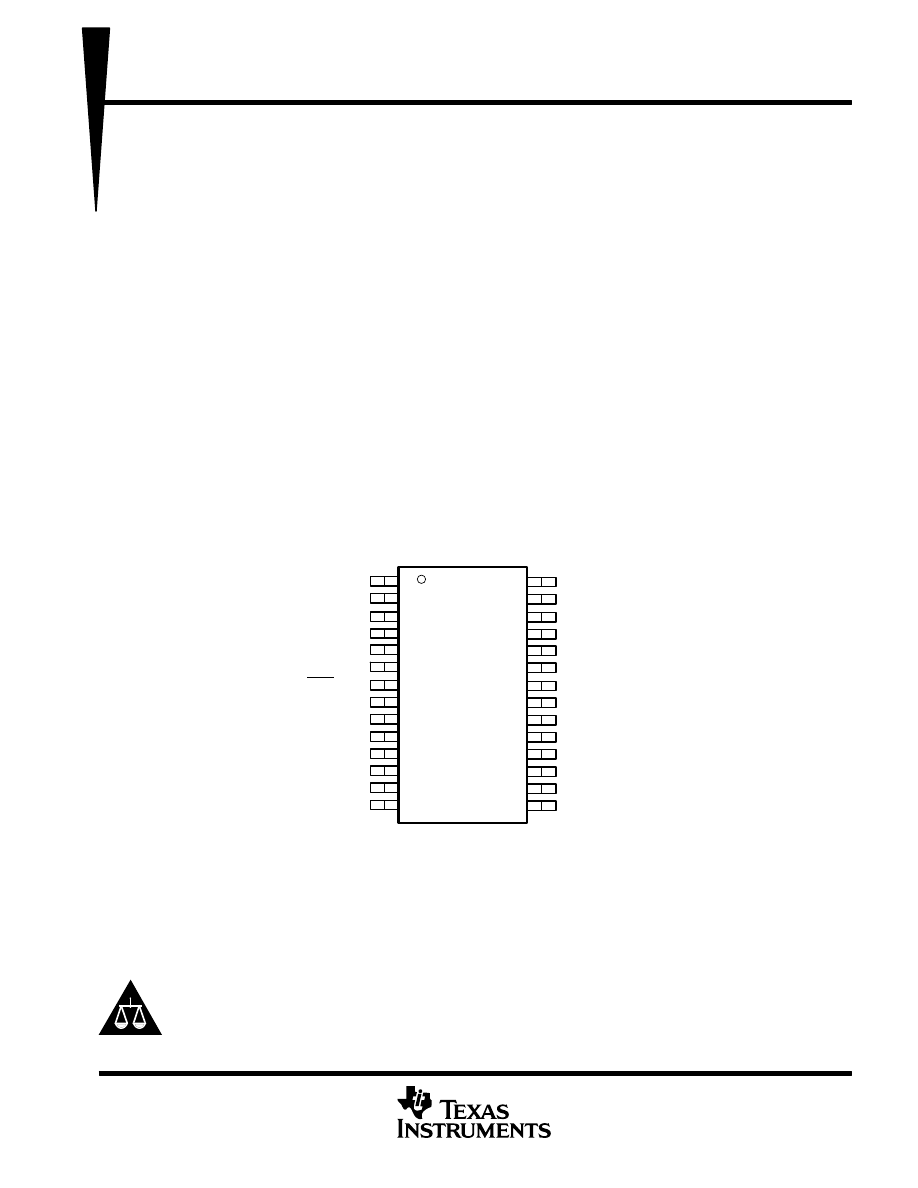
MSP430x12x
MIXED SIGNAL MICROCONTROLLER
SLAS312A – JULY 2001 – REVISED MARCH 2003
1
POST OFFICE BOX 655303
•
DALLAS, TEXAS 75265
D
Low Supply Voltage Range 1.8 V – 3.6 V
D
Ultralow-Power Consumption:
– Active Mode: 200
µ
A at 1 MHz, 2.2 V
– Standby Mode: 0.7
µ
A
– Off Mode (RAM Retention): 0.1
µ
A
D
Five Power Saving Modes
D
Wake-Up From Standby Mode in 6
µ
s
D
16-Bit RISC Architecture, 125 ns
Instruction Cycle Time
D
Basic Clock Module Configurations:
– Various Internal Resistors
– Single External Resistor
– 32 kHz Crystal
– High Frequency Crystal
– Resonator
– External Clock Source
D
16-Bit Timer_A With Three
Capture/Compare Registers
D
On-Chip Comparator for Analog Signal
Compare Function or Slope A/D
Conversion
D
Serial Communication Interface (USART)
Software-Selects Asynchronous UART or
Synchronous SPI
D
Serial Onboard Programming,
No External Programming Voltage Needed
Programmable Code Protection by Security
Fuse
D
Family Members Include:
MSP430F122:
4KB + 256B Flash Memory
256B RAM
MSP430F123:
8KB + 256B Flash Memory
256B RAM
D
Available in a 28-Pin Plastic Small-Outline
Wide Body (SOWB) Package and 28-Pin
Plastic Thin Shrink Small-Outline Package
(TSSOP)
D
For Complete Module Descriptions, See the
MSP430x1xx Family User’s Guide,
Literature Number SLAU049
1
2
3
4
5
6
7
8
9
10
11
12
13
14
28
27
26
25
24
23
22
21
20
19
18
17
16
15
TEST
V
CC
P2.5/R
osc
V
SS
XOUT
XIN
RST/NMI
P2.0/ACLK
P2.1/INCLK
P2.2/CAOUT/TAO
P3.0/STE0
P3.1/SIMO0
P3.2/SOMI0
P3.3/UCLK0
P1.7/TA2/TDO/TDI
P1.6/TA1/TDI
P1.5/TA0/TMS
P1.4/SMCLK/TCK
P1.3/TA2
P1.2/TA1
P1.1/TA0
P1.0/TACLK
P2.4/CA1/TA2
P2.3/CA0/TA1
P3.7
P3.6
P3.5/URXD0
P3.4/UTXD0
DW OR PW PACKAGE
(TOP VIEW)
description
The Texas Instruments MSP430 family of ultralow power microcontrollers consist of several devices featuring
different sets of peripherals targeted for various applications. The architecture, combined with five low power
modes is optimized to achieve extended battery life in portable measurement applications. The device features
a powerful 16-bit RISC CPU, 16-bit registers, and constant generators that attribute to maximum code efficiency.
The digitally controlled oscillator (DCO) allows wake-up from low-power modes to active mode in less than 6
µ
s.
Please be aware that an important notice concerning availability, standard warranty, and use in critical applications of
Texas Instruments semiconductor products and disclaimers thereto appears at the end of this data sheet.
Copyright
2001, – 2003 Texas Instruments Incorporated
PRODUCTION DATA information is current as of publication date.
Products conform to specifications per the terms of Texas Instruments
standard warranty. Production processing does not necessarily include
testing of all parameters.
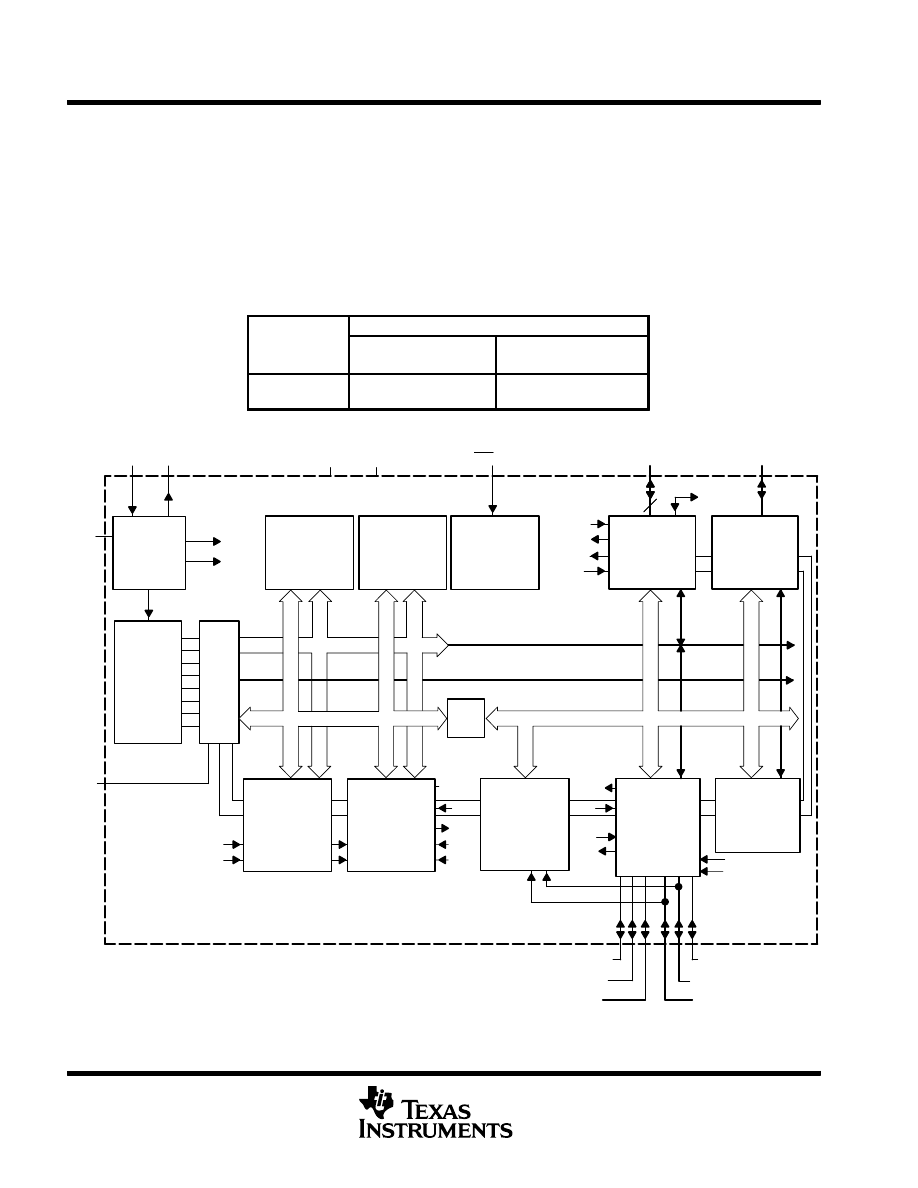
MSP430x12x
MIXED SIGNAL MICROCONTROLLER
SLAS312A – JULY 2001 – REVISED MARCH 2003
2
POST OFFICE BOX 655303
•
DALLAS, TEXAS 75265
description (continued)
The MSP430F12x series is an ultralow-power mixed signal microcontroller with a built-in 16-bit timer and
twenty-two I/O pins.The MSP430F12x series also has a built-in communication capability using asynchronous
(UART) and synchronous (SPI) protocols in addition to a versatile analog comparator.
Typical applications include sensor systems that capture analog signals, convert them to digital values, and then
process the data and display them or transmit them to a host system. Stand alone RF sensor front end is another
area of application. The I/O port inputs provide single slope A/D conversion capability on resistive sensors.
AVAILABLE OPTIONS
PACKAGED DEVICES
TA
PLASTIC 28-PIN SOWB
(DW)
PLASTIC 28-PIN TSSOP
(PW)
40
°
C to 85
°
C
MSP430F122IDW
MSP430F122IPW
– 40
°
C to 85
°
C
S
30
MSP430F123IDW
S
30
MSP430F123IPW
functional block diagram
ACLK
SMCLK
Power-on-
Reset
I/O Port P1
CPU
Incl. 16 Reg.
Test
JTAG
Bus
Conv
MAB,
MDB,
MAB, 4 Bit
MDB, 8 Bit
MCB
XIN
XOUT
VCC
VSS
RST/NMI
P1.0–7
DCOR
ACLK
P2.0 / ACLK
Rosc
TEST
Outx
MCLK
ACLK
SMCLK
Outx
CCIx
CCIx
TACLK
INCLK
INCLK
Out0
CCI0
JTAG
CCIxA
TACLK
SMCLK
I/O Port P2
6 I/O’s All With
8
Interrupt
Capabililty
Comparator_A
Input Multiplexer
RC Filtered O/P
Internal Vref
Analog Switch
P2.1 / INCLK
P2.2 / CAOUT/TA0
P2.5 / Rosc
P2.4 / CA1/TA2
P2.3 / CA0/TA1
CCI1
+ Flash INFO
4KB/8KB Flash
8 I/O’s, All With
Interrupt
Capabililty
P1.0–7
8
P3.0-7
I/O
Port P3
256B
RAM
Watchdog
Timer
15/16 Bit
or
CCI1
USART
UART
Mode
SPI
Mode
Timer_A
3 CC
CCR0/1/2
x = 0, 1, 2
Register
16 Bit
16 bit
Oscillator
System Clock

MSP430x12x
MIXED SIGNAL MICROCONTROLLER
SLAS312A – JULY 2001 – REVISED MARCH 2003
3
POST OFFICE BOX 655303
•
DALLAS, TEXAS 75265
Terminal Functions
TERMINAL
TERMINAL
I/O
DESCRIPTION
NAME
NO.
I/O
DESCRIPTION
P1.0/TACLK
21
I/O
General-purpose digital I/O pin/Timer_A, clock signal TACLK input
P1.1/TA0
22
I/O
General-purpose digital I/O pin/Timer_A, capture: CCI0A input, compare: Out0 output
P1.2/TA1
23
I/O
General-purpose digital I/O pin/Timer_A, capture: CCI1A input, compare: Out1 output
P1.3/TA2
24
I/O
General-purpose digital I/O pin/Timer_A, capture: CCI2A input, compare: Out2 output
P1.4/SMCLK/TCK
25
I/O
General-purpose digital I/O pin/SMCLK signal output/test clock, input terminal for device programming
and test
P1.5/TA0/TMS
26
I/O
General-purpose digital I/O pin/Timer_A, compare: Out0 output/test mode select, input terminal for
device programming and test
P1.6/TA1/TDI
27
I/O
General-purpose digital I/O pin/Timer_A, compare: Out1 output/test data input terminal
P1.7/TA2/TDO/TDI†
28
I/O
General-purpose digital I/O pin/Timer_A, compare: Out2 output/test data output terminal or data input
during programming
P2.0/ACLK
8
I/O
General-purpose digital I/O pin/ACLK output
P2.1/INCLK
9
I/O
General-purpose digital I/O pin/Timer_A, clock signal at INCLK
P2.2/CAOUT/TA0
10
I/O
General-purpose digital I/O pin/Timer_A, capture: CCI0B input/comparator_A, output
P2.3/CA0/TA1
19
I/O
General-purpose digital I/O pin/Timer_A, compare: Out1 output/comparator_A, input
P2.4/CA1/TA2
20
I/O
General-purpose digital I/O pin/Timer_A, compare: Out2 output/comparator_A, input
P2.5/Rosc
3
I/O
General-purpose digital I/O pin/Input for external resistor that defines the DCO nominal frequency
P3.0/STE0
11
I/O
General digital I/O, slave transmit enable—USART0/SPI mode
P3.1/SIMO0
12
I/O
General digital I/O, slave in/master out of USART0/SPI mode
P3.2/SOMI0
13
I/O
General digital I/O, slave out/master in of USART0/SPI mode
P3.3/UCLK0
14
I/O
General digital I/O, external clock input—USART0/UART or SPI mode, clock output—USART0/SPI
mode clock input
P3.4/UTXD0
15
I/O
General digital I/O, transmit data out—USART0/UART mode
P3.5/URXD0
16
I/O
General digital I/O, receive data in—USART0/UART mode
P3.6
17
I/O
General digital I/O
P3.7
18
I/O
General digital I/O
RST/NMI
7
I
Reset or nonmaskable interrupt input
TEST
1
I
Select of test mode for JTAG pins on Port1
VCC
2
Supply voltage
VSS
4
Ground reference
XIN
6
I
Input terminal of crystal oscillator
XOUT
5
I/O
Output terminal of crystal oscillator
† TDO or TDI is selected via JTAG instruction.
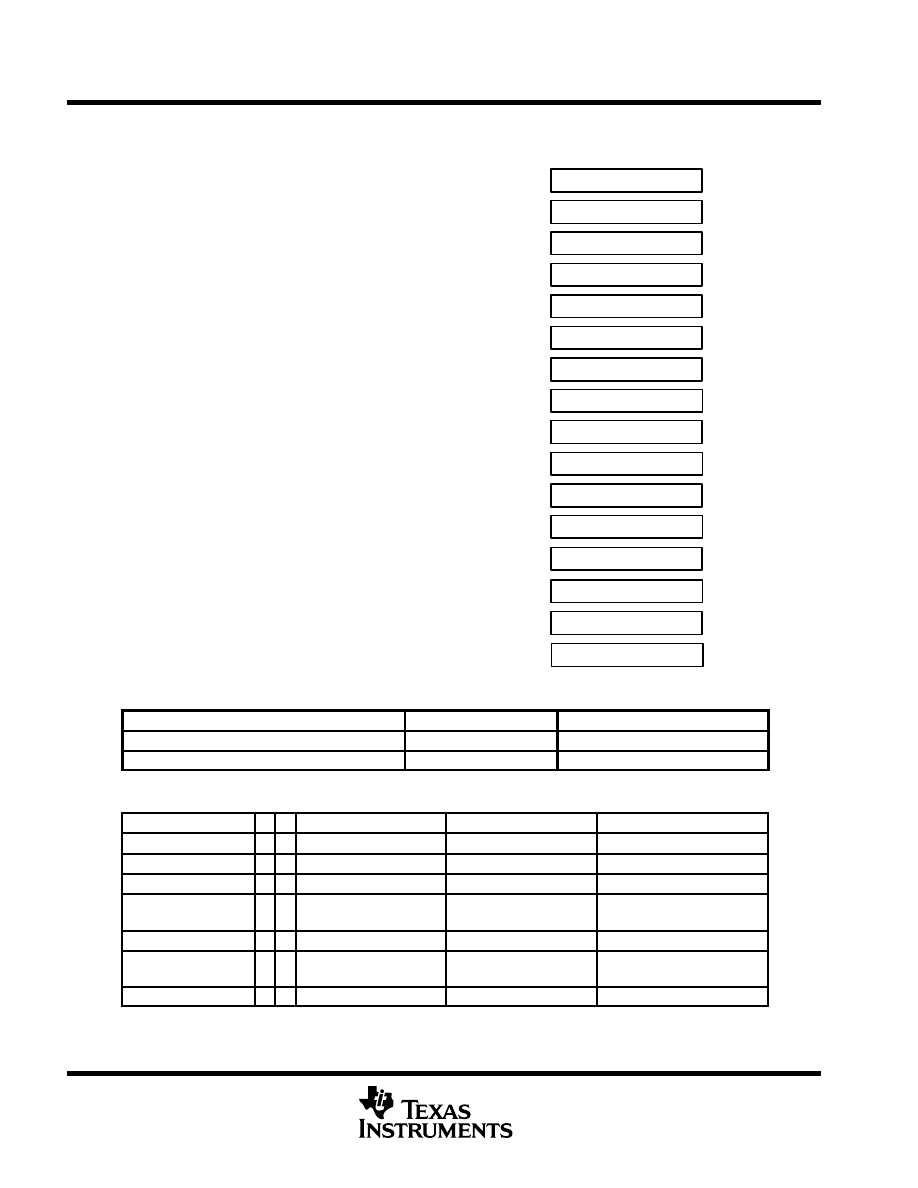
General-Purpose Register
Program Counter
Stack Pointer
Status Register
Constant Generator
General-Purpose Register
General-Purpose Register
General-Purpose Register
PC/R0
SP/R1
SR/CG1/R2
CG2/R3
R4
R5
R12
R13
General-Purpose Register
General-Purpose Register
R6
R7
General-Purpose Register
General-Purpose Register
R8
R9
General-Purpose Register
General-Purpose Register
R10
R11
General-Purpose Register
General-Purpose Register
R14
R15
MSP430x12x
MIXED SIGNAL MICROCONTROLLER
SLAS312A – JULY 2001 – REVISED MARCH 2003
4
POST OFFICE BOX 655303
•
DALLAS, TEXAS 75265
short-form description
CPU
The MSP430 CPU has a 16-bit RISC architecture
that is highly transparent to the application. All
operations, other than program-flow instructions,
are performed as register operations in conjunc-
tion with seven addressing modes for source
operand and four addressing modes for destina-
tion operand.
The CPU is integrated with 16 registers that
provide reduced instruction execution time. The
register-to-register operation execution time is
one cycle of the CPU clock.
Four of the registers, R0 to R3, are dedicated as
program counter, stack pointer, status register,
and constant generator respectively. The remain-
ing registers are general-purpose registers.
Peripherals are connected to the CPU using data,
address, and control buses, and can be handled
with all instructions.
instruction set
The instruction set consists of 51 instructions with
three formats and seven address modes. Each
instruction can operate on word and byte data.
Table 1 shows examples of the three types of
instruction formats; the address modes are listed
in Table 2.
Table 1. Instruction Word Formats
Dual operands, source-destination
e.g. ADD R4,R5
R4 + R5 –––> R5
Single operands, destination only
e.g. CALL R8
PC ––>(TOS), R8––> PC
Relative jump, un/conditional
e.g. JNE
Jump-on-equal bit = 0
Table 2. Address Mode Descriptions
ADDRESS MODE
S
D
SYNTAX
EXAMPLE
OPERATION
Register
n n
MOV Rs,Rd
MOV R10,R11
R10 ––> R11
Indexed
n n
MOV X(Rn),Y(Rm)
MOV 2(R5),6(R6)
M(2+R5)––> M(6+R6)
Symbolic (PC relative)
n n
MOV EDE,TONI
M(EDE) ––> M(TONI)
Absolute
n n
MOV and MEM,and
TCDAT
M(MEM) ––> M(TCDAT)
Indirect
n
MOV @Rn,Y(Rm)
MOV @R10,Tab(R6)
M(R10) ––> M(Tab+R6)
Indirect
autoincrement
n
MOV @Rn+,Rm
MOV @R10+,R11
M(R10) ––> R11
R10 + 2––> R10
Immediate
n
MOV #X,TONI
MOV #45,TONI
#45 ––> M(TONI)
NOTE: S = source D = destination

MSP430x12x
MIXED SIGNAL MICROCONTROLLER
SLAS312A – JULY 2001 – REVISED MARCH 2003
5
POST OFFICE BOX 655303
•
DALLAS, TEXAS 75265
operating modes
The MSP430 has one active mode and five software selectable low-power modes of operation. An interrupt
event can wake up the device from any of the five low-power modes, service the request and restore back to
the low-power mode on return from the interrupt program.
The following six operating modes can be configured by software:
D
Active mode AM;
–
All clocks are active
D
Low-power mode 0 (LPM0);
–
CPU is disabled
ACLK and SMCLK remain active. MCLK is disabled
D
Low-power mode 1 (LPM1);
–
CPU is disabled
ACLK and SMCLK remain active. MCLK is disabled
DCO’s dc-generator is disabled if DCO not used in active mode
D
Low-power mode 2 (LPM2);
–
CPU is disabled
MCLK and SMCLK are disabled
DCO’s dc-generator remains enabled
ACLK remains active
D
Low-power mode 3 (LPM3);
–
CPU is disabled
MCLK and SMCLK are disabled
DCO’s dc-generator is disabled
ACLK remains active
D
Low-power mode 4 (LPM4);
–
CPU is disabled
ACLK is disabled
MCLK and SMCLK are disabled
DCO’s dc-generator is disabled
Crystal oscillator is stopped
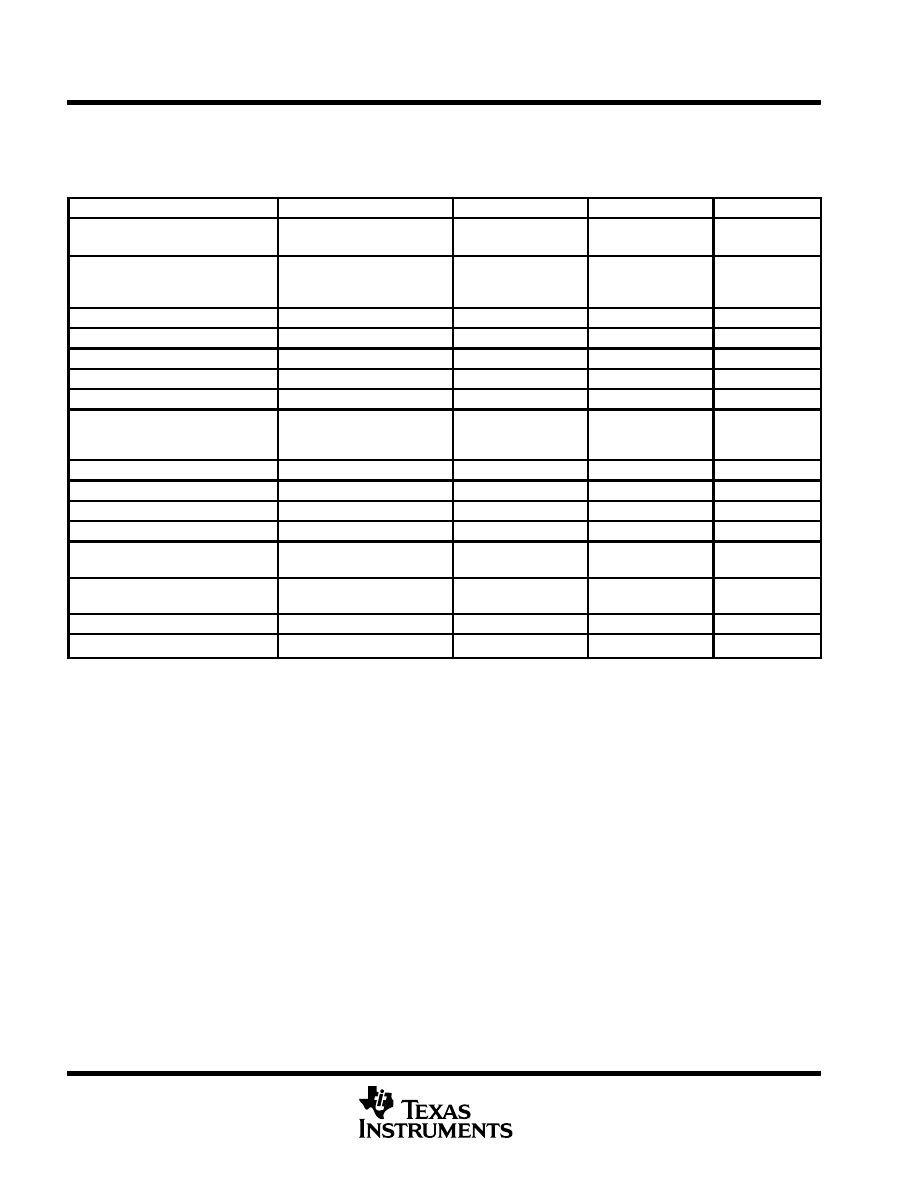
MSP430x12x
MIXED SIGNAL MICROCONTROLLER
SLAS312A – JULY 2001 – REVISED MARCH 2003
6
POST OFFICE BOX 655303
•
DALLAS, TEXAS 75265
interrupt vector addresses
The interrupt vectors and the power-up starting address are located in the memory with an address range of
0FFFFh-0FFE0h. The vector contains the 16-bit address of the appropriate interrupt handler instruction
sequence.
INTERRUPT SOURCE
INTERRUPT FLAG
SYSTEM INTERRUPT
WORD ADDRESS
PRIORITY
Power-up, external reset, watchdog
WDTIFG (see Note1)
KEYV (see Note 1)
Reset
0FFFEh
15, highest
NMI, oscillator fault, flash memory
access violation
NMIIFG (see Notes 1 and 4)
OFIFG (see Notes 1 and 4)
ACCVIFG (see Notes 1 and 4)
(non)-maskable,
(non)-maskable,
(non)-maskable
0FFFCh
14
0FFFAh
13
0FFF8h
12
Comparator_A
CAIFG
maskable
0FFF6h
11
Watchdog timer
WDTIFG
maskable
0FFF4h
10
Timer_A
TACCR0 CCIFG (see Note 2)
maskable
0FFF2h
9
Timer_A
TACCR1 and TACCR2
CCIFGs, TAIFG
(see Notes 1 and 2)
maskable
0FFF0h
8
USART0 receive
URXIFG0
maskable
0FFEEh
7
USART0 transmit
UTXIFG0
maskable
0FFECh
6
0FFEAh
5
0FFE8h
4
I/O Port P2 (eight flags – see Note 3)
P2IFG.0 to P2IFG.7
(see Notes 1 and 2)
maskable
0FFE6h
3
I/O Port P1 (eight flags)
P1IFG.0 to P1IFG.7
(see Notes 1 and 2)
maskable
0FFE4h
2
0FFE2h
1
0FFE0h
0, lowest
NOTES:
1. Multiple source flags
2. Interrupt flags are located in the module
3. There are eight Port P2 interrupt flags, but only six Port P2 I/O pins (P2.0–5) are implemented on the ’12x devices.
4. (non)-maskable: the individual interrupt enable bit can disable an interrupt event, but the general interrupt enable cannot.
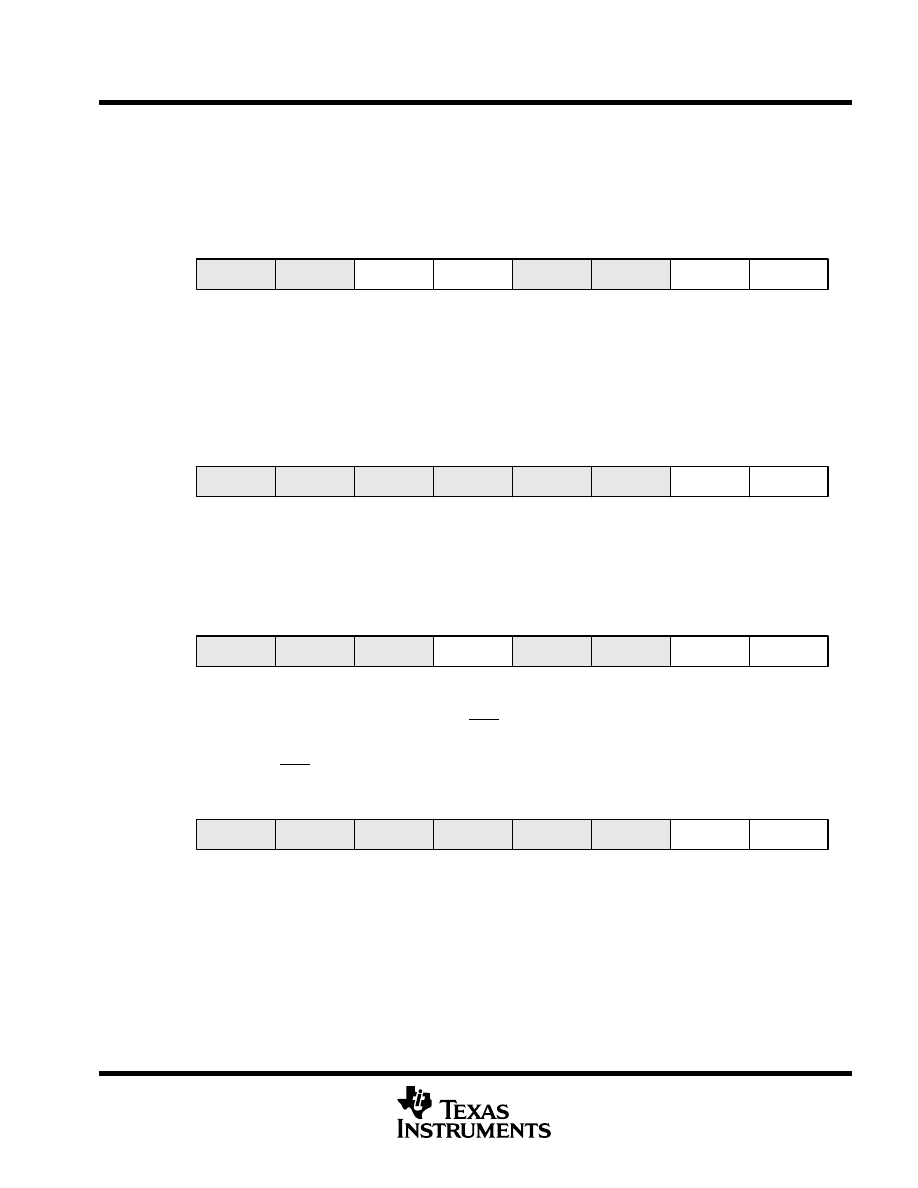
MSP430x12x
MIXED SIGNAL MICROCONTROLLER
SLAS312A – JULY 2001 – REVISED MARCH 2003
7
POST OFFICE BOX 655303
•
DALLAS, TEXAS 75265
special function registers
Most interrupt and module enable bits are collected into the lowest address space. Special function register bits
that are not allocated to a functional purpose are not physically present in the device. Simple software access
is provided with this arrangement.
interrupt enable 1 and 2
7
6
5
4
0
OFIE
WDTIE
3
2
1
rw-0
rw-0
rw-0
Address
0h
NMIIE
ACCVIE
rw-0
WDTIE:
Watchdog-timer interrupt enable. Inactive if watchdog mode is selected. Active if watchdog
timer is configured in interval timer mode.
OFIE:
Oscillator-fault-interrupt enable
NMIIE:
Nonmaskable-interrupt enable
ACCVIE:
Flash access violation interrupt enable
7
6
5
4
0
3
2
1
Address
01h
UTXIE0
URXIE0
rw-0
rw-0
URXIE0:
USART0, UART, and SPI receive-interrupt enable
UTXIE0:
USART0, UART, and SPI transmit-interrupt enable
interrupt flag register 1 and 2
7
6
5
4
0
OFIFG
WDTIFG
3
2
1
rw-0
rw-1
rw-0
Address
02h
NMIIFG
WDTIFG:
Set on watchdog timer overflow (in watchdog mode) or security key violation. Reset on V
CC
power up or a reset condition at the RST/NMI pin in reset mode.
OFIFG:
Flag set on oscillator fault
NMIIFG:
Set via RST/NMI pin
7
6
5
4
0
3
2
1
Address
03h
UTXIFG0
URXIFG0
rw-0
rw-0
URXIFG0:
USART0, UART, and SPI receive flag
UTXIFG0:
USART0, UART, and SPI transmit flag
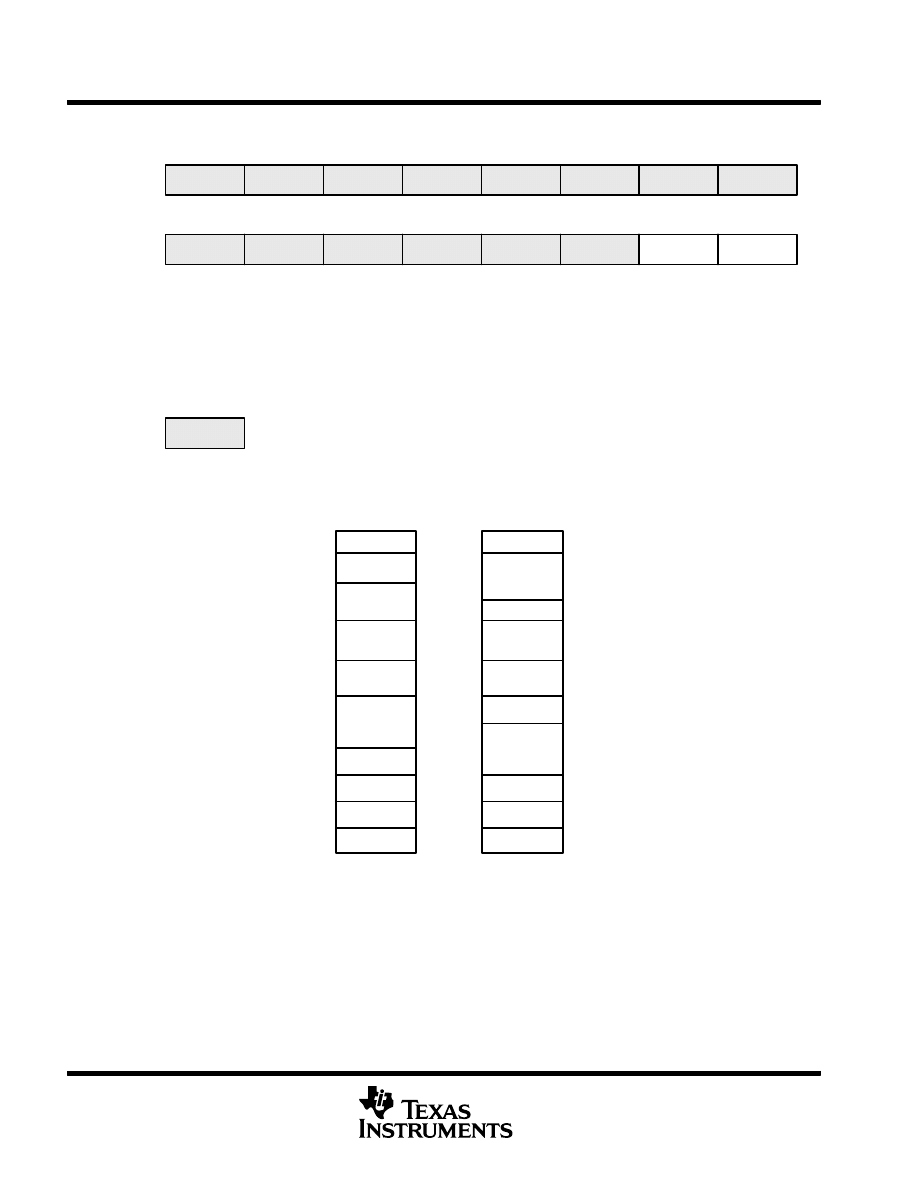
MSP430x12x
MIXED SIGNAL MICROCONTROLLER
SLAS312A – JULY 2001 – REVISED MARCH 2003
8
POST OFFICE BOX 655303
•
DALLAS, TEXAS 75265
module enable registers 1 and 2
7
6
5
4
0
3
2
1
Address
04h
7
6
5
4
0
3
2
1
Address
05h
UTXE0
URXE0
USPIE0
rw-0
rw-0
URXE0:
USART0, UART receive enable
UTXE0:
USART0, UART transmit enable
USPIE0:
USART0, SPI (synchronous peripheral interface) transmit and receive enable
Legend
rw:
rw-0:
Bit can be read and written.
Bit can be read and written. It is reset by PUC
SFR bit is not present in device.
memory organization
Int. Vector
8 KB
Flash
Segment0–15
256B RAM
16b Per.
8b Per.
SFR
FFFFh
FFE0h
FFDFh
02FFh
0200h
01FFh
0100h
00FFh
0010h
000Fh
0000h
MSP430F123
E000h
Main
Memory
10FFh
2
×
128B
Flash
SegmentA,B
Information
Memory
1000h
1 KB
Boot ROM
0C00h
Int. Vector
4 KB Flash
Segment0–7
256B RAM
16b Per.
8b Per.
SFR
FFDFh
F000h
02FFh
0200h
0100h
00FFh
0010h
000Fh
0000h
MSP430F122
1 KB
Boot ROM
2
×
128B
Flash
SegmentA,B
10FFh
1000h
01FFh
0C00h
0FFFh
FFFFh
FFE0h
0FFFh

MSP430x12x
MIXED SIGNAL MICROCONTROLLER
SLAS312A – JULY 2001 – REVISED MARCH 2003
9
POST OFFICE BOX 655303
•
DALLAS, TEXAS 75265
bootstrap loader (BSL)
The MSP430 bootstrap loader (BSL) enables users to program the flash memory or RAM using a UART serial
interface. Access to the MSP430 memory via the BSL is protected by user-defined password. For complete
description of the features of the BSL and its implementation, see the Application report Features of the MSP430
Bootstrap Loader, Literature Number SLAA089.
flash memory
The flash memory can be programmed via the JTAG port, the bootstrap loader, or in-system by the CPU. The
CPU can perform single-byte and single-word writes to the flash memory. Features of the flash memory include:
D
Flash memory has n segments of main memory and two segments of information memory (A and B) of 128
bytes each. Each segment in main memory is 512 bytes in size.
D
Segments 0 to n may be erased in one step, or each segment may be individually erased.
D
Segments A and B can be erased individually, or as a group with segments 0–n.
Segments A and B are also called information memory.
D
New devices may have some bytes programmed in the information memory (needed for test during
manufacturing). The user should perform an erase of the information memory prior to the first use.

MSP430x12x
MIXED SIGNAL MICROCONTROLLER
SLAS312A – JULY 2001 – REVISED MARCH 2003
10
POST OFFICE BOX 655303
•
DALLAS, TEXAS 75265
peripherals
Peripherals are connected to the CPU through data, address, and control busses and can be handled using
all instructions.
oscillator and system clock
The clock system in the MSP430x12x devices is supported by the basic clock module that includes support for
a 32768-Hz watch crystal oscillator, an internal digitally-controlled oscillator (DCO) and a high frequency crystal
oscillator. The basic clock module is designed to meet the requirements of both low system cost and low-power
consumption. The internal DCO provides a fast turn-on clock source and stabilizes in less than 6
µ
s. The basic
clock module provides the following clock signals:
D
Auxiliary clock (ACLK), sourced from a 32768-Hz watch crystal or a high frequency crystal.
D
Main clock (MCLK), the system clock used by the CPU.
D
Sub-Main clock (SMCLK), the sub-system clock used by the peripheral modules.
digital I/O
There are three 8-bit I/O ports implemented—ports P1, P2, and P3 (only six port P2 I/O signals are available
on external pins):
D
All individual I/O bits are independently programmable.
D
Any combination of input, output, and interrupt conditions is possible.
D
Edge-selectable interrupt input capability for all the eight bits of ports P1 and six bits of port P2.
D
Read/write access to port-control registers is supported by all instructions.
NOTE:
Six bits of port P2, P2.0 to P2.5, are available on external pins – but all control and data bits for port
P2 are implemented. Port P3 has no interrupt capability.
watchdog timer
The primary function of the watchdog timer (WDT) module is to perform a controlled system restart after a
software problem occurs. If the selected time interval expires, a system reset is generated. If the watchdog
function is not needed in an application, the module can be configured as an interval timer and can generate
interrupts at selected time intervals.
USART0
The MSP430x12x devices have one hardware universal synchronous/asynchronous receive transmit
(USART0) peripheral module that is used for serial data communication. The USART supports synchronous
SPI (3 or 4 pin) and asynchronous UART communication protocols, using double-buffered transmit and receive
channels.
timer_A3
Timer_A3 is a 16-bit timer/counter with three capture/compare registers. Timer_A3 can support multiple
capture/compares, PWM outputs, and interval timing. Timer_A3 also has extensive interrupt capabilities.
Interrupts may be generated from the counter on overflow conditions and from each of the capture/compare
registers.
comparator_A
The primary function of the comparator_A module is to support precision slope analog–to–digital conversions,
battery–voltage supervision, and monitoring of external analog signals.
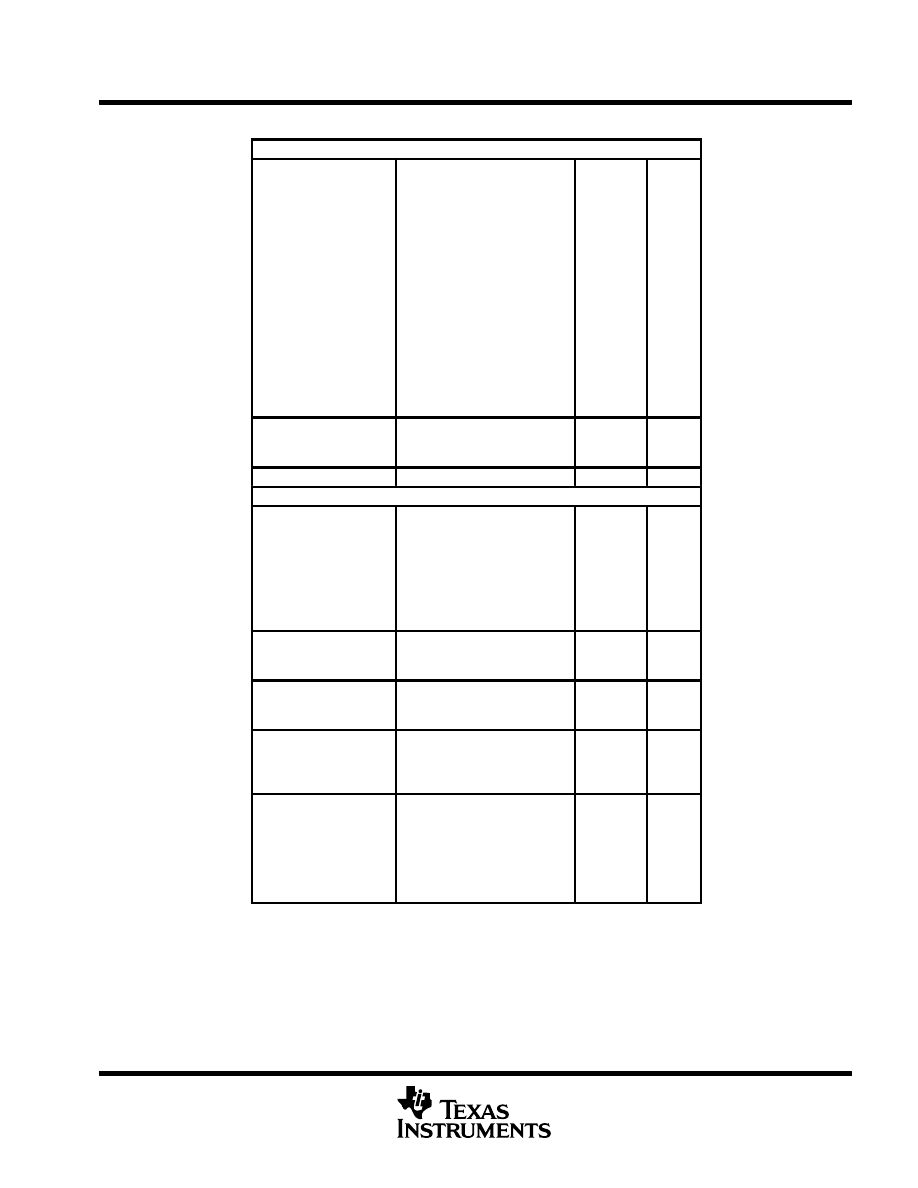
MSP430x12x
MIXED SIGNAL MICROCONTROLLER
SLAS312A – JULY 2001 – REVISED MARCH 2003
11
POST OFFICE BOX 655303
•
DALLAS, TEXAS 75265
peripheral file map
PERIPHERALS WITH WORD ACCESS
Timer_A
Reserved
Reserved
Reserved
Reserved
Capture/compare register
Capture/compare register
Capture/compare register
Timer_A register
Reserved
Reserved
Reserved
Reserved
Capture/compare control
Capture/compare control
Capture/compare control
Timer_A control
Timer_A interrupt vector
TACCR2
TACCR1
TACCR0
TAR
TACCTL2
TACCTL1
TACCTL0
TACTL
TAIV
017Eh
017Ch
017Ah
0178h
0176h
0174h
0172h
0170h
016Eh
016Ch
016Ah
0168h
0166h
0164h
0162h
0160h
012Eh
Flash Memory
Flash control 3
Flash control 2
Flash control 1
FCTL3
FCTL2
FCTL1
012Ch
012Ah
0128h
Watchdog
Watchdog/timer control
WDTCTL
0120h
PERIPHERALS WITH BYTE ACCESS
USART0
Transmit buffer
Receive buffer
Baud rate
Baud rate
Modulation control
Receive control
Transmit control
USART control
U0TXBUF
U0RXBUF
U0BR1
U0BR0
U0MCTL
U0RCTL
U0TCTL
U0CTL
077h
076h
075h
074h
073h
072h
071h
070h
Comparator_A
Comparator_A port disable
Comparator_A control2
Comparator_A control1
CAPD
CACTL2
CACTL1
05Bh
05Ah
059h
Basic Clock
Basic clock sys. control2
Basic clock sys. control1
DCO clock freq. control
BCSCTL2
BCSCTL1
DCOCTL
058h
057h
056h
Port P3
Port P3 selection
Port P3 direction
Port P3 output
Port P3 input
P3SEL
P3DIR
P3OUT
P3IN
01Bh
01Ah
019h
018h
Port P2
Port P2 selection
Port P2 interrupt enable
Port P2 interrupt edge select
Port P2 interrupt flag
Port P2 direction
Port P2 output
Port P2 input
P2SEL
P2IE
P2IES
P2IFG
P2DIR
P2OUT
P2IN
02Eh
02Dh
02Ch
02Bh
02Ah
029h
028h
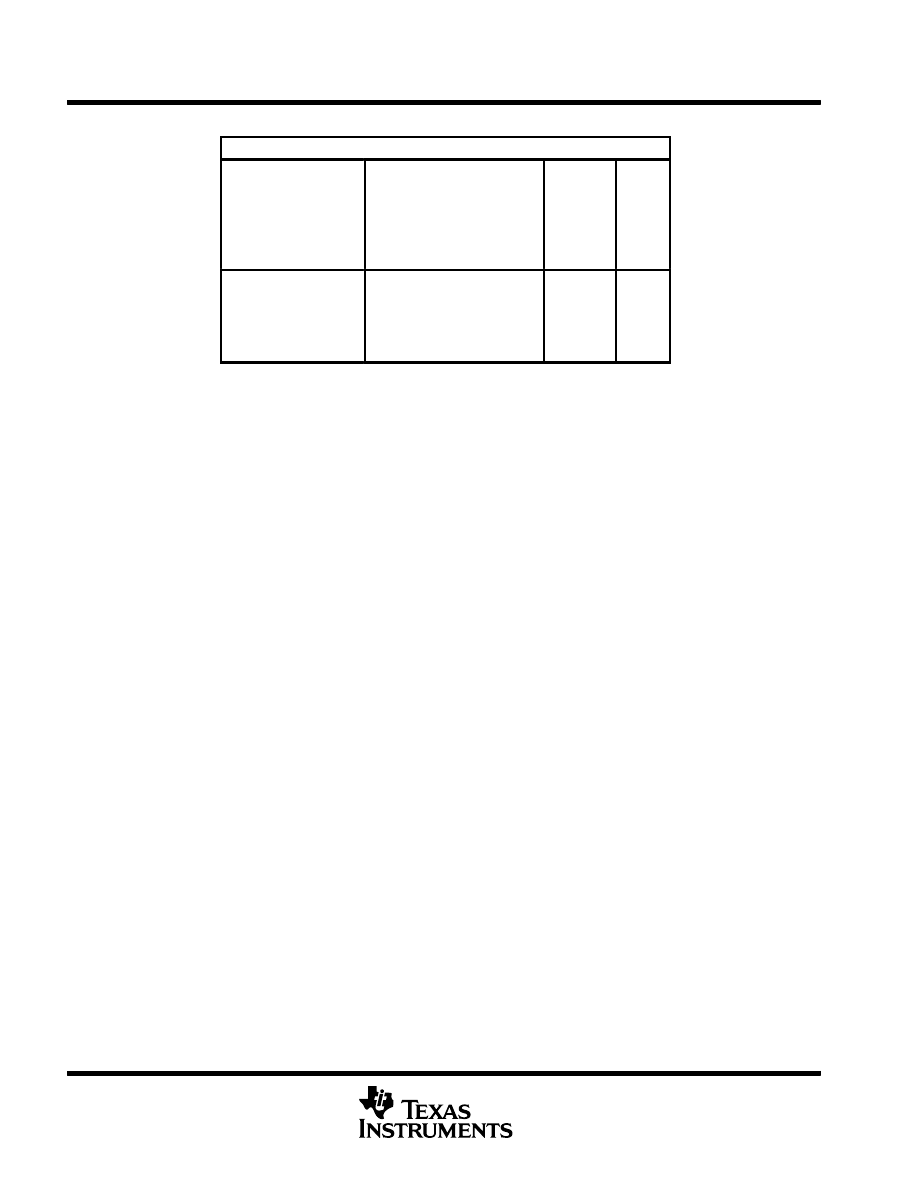
MSP430x12x
MIXED SIGNAL MICROCONTROLLER
SLAS312A – JULY 2001 – REVISED MARCH 2003
12
POST OFFICE BOX 655303
•
DALLAS, TEXAS 75265
peripheral file map (continued)
PERIPHERALS WITH BYTE ACCESS (CONTINUED)
Port P1
Port P1 selection
Port P1 interrupt enable
Port P1 interrupt edge select
Port P1 interrupt flag
Port P1 direction
Port P1 output
Port P1 input
P1SEL
P1IE
P1IES
P1IFG
P1DIR
P1OUT
P1IN
026h
025h
024h
023h
022h
021h
020h
Special Function
Module enable2
Module enable1
SFR interrupt flag2
SFR interrupt flag1
SFR interrupt enable2
SFR interrupt enable1
ME2
ME1
IFG2
IFG1
IE2
IE1
005h
004h
003h
002h
001h
000h
absolute maximum ratings
†
Voltage applied at V
CC
to V
SS
–0.3 V to 4.1 V
. . . . . . . . . . . . . . . . . . . . . . . . . . . . . . . . . . . . . . . . . . . . . . . . . . . . . .
Voltage applied to any pin (referenced to V
SS
)
–0.3 V to V
CC
+0.3 V
. . . . . . . . . . . . . . . . . . . . . . . . . . . . . . . . . . .
Diode current at any device terminal
±
2 mA
. . . . . . . . . . . . . . . . . . . . . . . . . . . . . . . . . . . . . . . . . . . . . . . . . . . . . . . .
Storage temperature, T
stg
(unprogrammed device)
–55
°
C to 150
°
C
. . . . . . . . . . . . . . . . . . . . . . . . . . . . . . . . . . .
Storage temperature, T
stg
(programmed device)
–40
°
C to 85
°
C
. . . . . . . . . . . . . . . . . . . . . . . . . . . . . . . . . . . . . .
† Stresses beyond those listed under “absolute maximum ratings” may cause permanent damage to the device. These are stress ratings only, and
functional operation of the device at these or any other conditions beyond those indicated under “recommended operating conditions” is not
implied. Exposure to absolute-maximum-rated conditions for extended periods may affect device reliability.
NOTE: All voltages referenced to VSS.
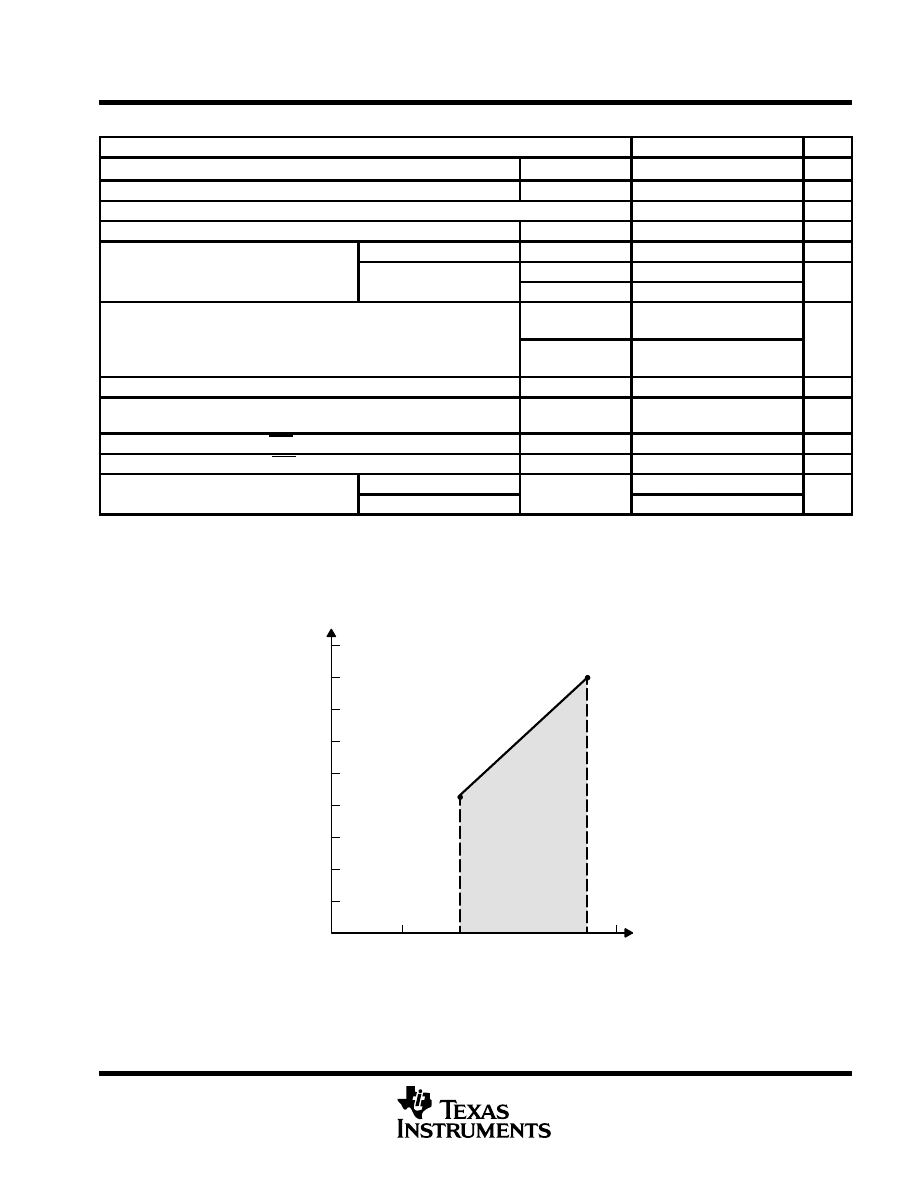
MSP430x12x
MIXED SIGNAL MICROCONTROLLER
SLAS312A – JULY 2001 – REVISED MARCH 2003
13
POST OFFICE BOX 655303
•
DALLAS, TEXAS 75265
recommended operating conditions
MIN
NOM
MAX
UNITS
Supply voltage during program execution VCC (see Note 1)
MSP430F12x
1 8
3 6
V
Supply voltage during program execution, VCC (see Note 1)
MSP430F12x
1.8
3.6
V
Supply voltage during program/erase flash memory, VCC
MSP430F12x
2.7
3.6
V
Supply voltage, VSS
0
V
Operating free-air temperature range, TA
MSP430F12x
–40
85
°
C
LFXT1
t l f
f
LF mode selected, XTS=0
Watch crystal
32 768
Hz
LFXT1 crystal frequency, f(LFXT1)
(see Note 2)
XT1 selected mode XTS=1
Ceramic resonator
450
8000
kHz
(see Note 2)
XT1 selected mode, XTS=1
Crystal
1000
8000
kHz
Processor frequency f(system) (MCLK signal)
VCC = 1.8 V,
MSP430F12x
dc
4.15
MHz
Processor frequency f(system) (MCLK signal)
VCC = 3.6 V,
MSP430F12x
dc
8
MHz
Flash timing generator frequency, f(FTG)
MSP430F12x
257
476
kHz
Cumulative program time, block write, t(CPT) (see Note 3)
VCC = 2.7 V/3.6 V
MSP430F12x
3
ms
Low-level input voltage (TEST, RST/NMI), VIL (excluding XIN, XOUT)
VCC = 2.2 V/3 V
VSS
VSS+0.6
V
High-level input voltage (TEST, RST/NMI), VIH (excluding XIN, XOUT)
VCC = 2.2 V/3 V
0.8VCC
VCC
V
Input levels at XIN XOUT
VIL(XIN, XOUT)
VCC = 2 2 V/3 V
VSS
0.2
×
VCC
V
Input levels at XIN, XOUT
VIH(XIN, XOUT)
VCC = 2.2 V/3 V
0.8
×
VCC
VCC
V
NOTES:
1. The LFXT1 oscillator in LF-mode requires a resistor of 5.1 M
Ω
from XOUT to VSS when VCC <2.5 V.
The LFXT1 oscillator in XT1-mode accepts a ceramic resonator or a crystal frequency of 4 MHz at VCC
≥
2.2 V.
The LFXT1 oscillator in XT1-mode accepts a ceramic resonator or a crystal frequency of 8 MHz at VCC
≥
2.8 V.
2. The LFXT1 oscillator in LF-mode requires a watch crystal.
The LFXT1 oscillator in XT1-mode accepts a ceramic resonator or a crystal.
3. The cumulative program time must not be exceeded during a block-write operation.
4.15 MHz
at 1.8 V
MSP430F12x Devices
NOTE: Minimum processor frequency is defined by system clock. Flash
program or erase operations require a minimum VCC of 2.7 V.
9
3
2
1
0
0
1
2
3
4
4
VCC – Supply Voltage – V
8 MHz at
3.6 V
5
6
7
8
–
Maximum Processor Frequency
–
MHz
f (system)
Figure 1. Frequency vs Supply Voltage
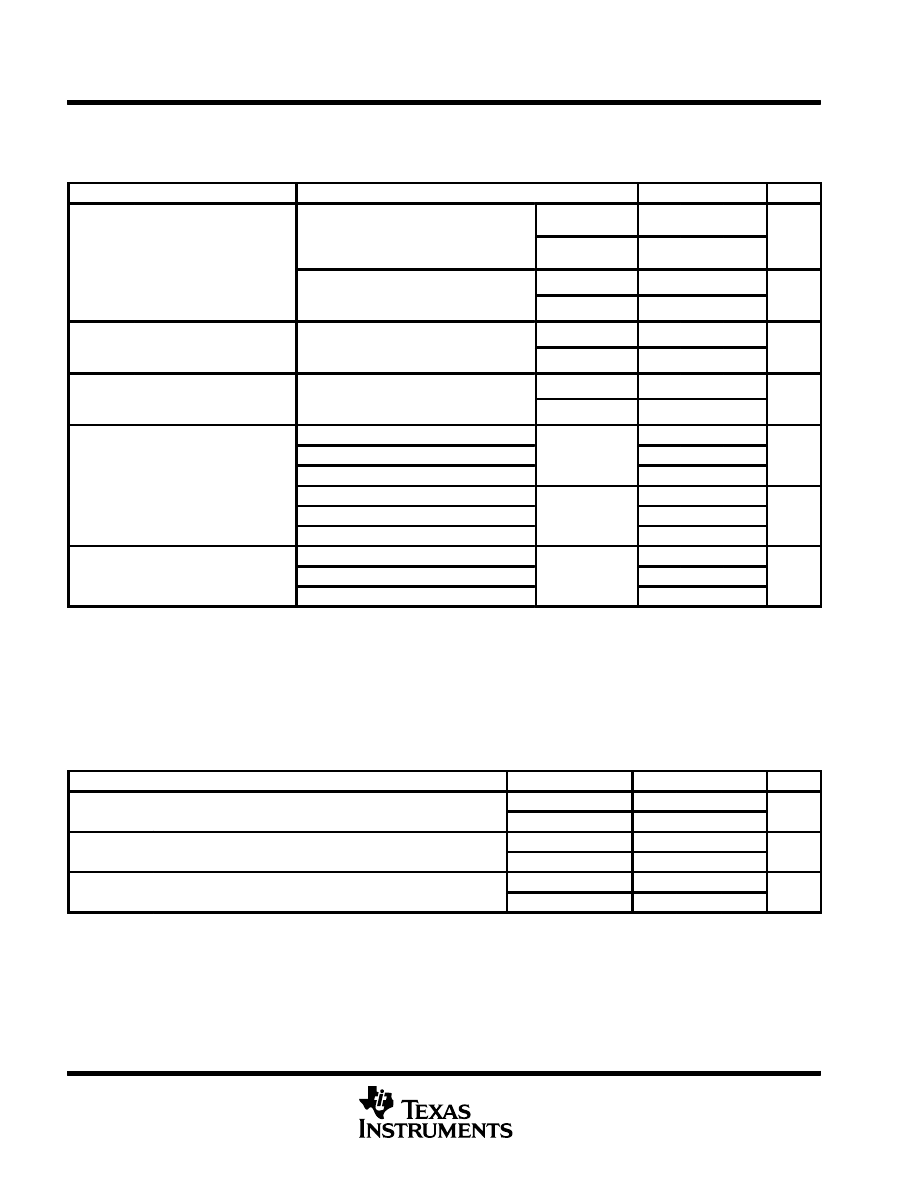
MSP430x12x
MIXED SIGNAL MICROCONTROLLER
SLAS312A – JULY 2001 – REVISED MARCH 2003
14
POST OFFICE BOX 655303
•
DALLAS, TEXAS 75265
electrical characteristics over recommended ranges of supply voltage and operating free-air
temperature (unless otherwise noted)
supply current (into V
CC
) excluding external current
PARAMETER
TEST CONDITIONS
MIN
TYP
MAX
UNIT
TA = –40
°
C +85
°
C,
fMCLK = f(SMCLK) = 1 MHz,
VCC = 2.2 V
200
250
µ
A
I(AM)
Active mode
MCLK
(SMCLK)
f(ACLK) = 32,768 Hz,
Program executes in Flash
VCC = 3 V
300
350
µ
A
(AM)
TA = –40
°
C +85
°
C,
f(MCLK) = f(SMCLK) = f(ACLK) = 4096 Hz
VCC = 2.2 V
3
5
µ
A
f(MCLK) = f(SMCLK) = f(ACLK) = 4096 Hz,
Program executes in Flash
VCC = 3 V
11
18
µ
A
I(CPUOff) Low power mode (LPM0)
TA = –40
°
C +85
°
C,
f(MCLK) = 0 f(SMCLK) = 1 MHz
VCC = 2.2 V
32
45
µ
A
I(CPUOff) Low-power mode, (LPM0)
f(MCLK) = 0, f(SMCLK) = 1 MHz,
f(ACLK) = 32,768 Hz
VCC = 3 V
55
70
µ
A
I(LPM2)
Low power mode (LPM2)
TA = –40
°
C +85
°
C,
f(MCLK) = f(SMCLK) = 0 MHz
VCC = 2.2 V
11
14
µ
A
I(LPM2)
Low-power mode, (LPM2)
f(MCLK) = f(SMCLK) = 0 MHz,
f(ACLK) = 32,768 Hz, SCG0 = 0
VCC = 3 V
17
22
µ
A
TA = –40
°
C
0.8
1.2
TA = 25
°
C
VCC = 2.2 V
0.7
1
µ
A
I(LPM3)
Low power mode (LPM3)
TA = 85
°
C
1.6
2.3
I(LPM3)
Low-power mode, (LPM3)
TA = –40
°
C
1.8
2.2
TA = 25
°
C
VCC = 3 V
1.6
1.9
µ
A
TA = 85
°
C
2.3
3.4
TA = –40
°
C
0.1
0.5
I(LPM4)
Low-power mode, (LPM4)
TA = 25
°
C
VCC = 2.2 V/3 V
0.1
0.5
µ
A
(
)
TA = 85
°
C
0.8
1.9
NOTE: All inputs are tied to 0 V or VCC. Outputs do not source or sink any current.
current consumption of active mode versus system frequency
I
AM
= I
AM[1 MHz]
×
f
system
[MHz]
current consumption of active mode versus supply voltage
I
AM
= I
AM[3 V]
+ 120
µ
A/V
×
(V
CC
–3 V)
Schmitt-trigger inputs Port P1 to Port P3; P1.0 to P1.7, P2.0 to P2.5, P3.0 to P3.7
PARAMETER
TEST CONDITIONS
MIN
TYP
MAX
UNIT
VIT
Positive going input threshold voltage
VCC = 2.2 V
1.1
1.5
V
VIT+
Positive-going input threshold voltage
VCC = 3 V
1.5
1.9
V
VIT
Negative going input threshold voltage
VCC = 2.2 V
0.4
0.9
V
VIT–
Negative-going input threshold voltage
VCC = 3 V
0.9
1.3
V
Vh
Input voltage hysteresis (VIT
VIT )
VCC = 2.2 V
0.3
1.1
V
Vhys
Input voltage hysteresis, (VIT+ – VIT–)
VCC = 3 V
0.5
1
V
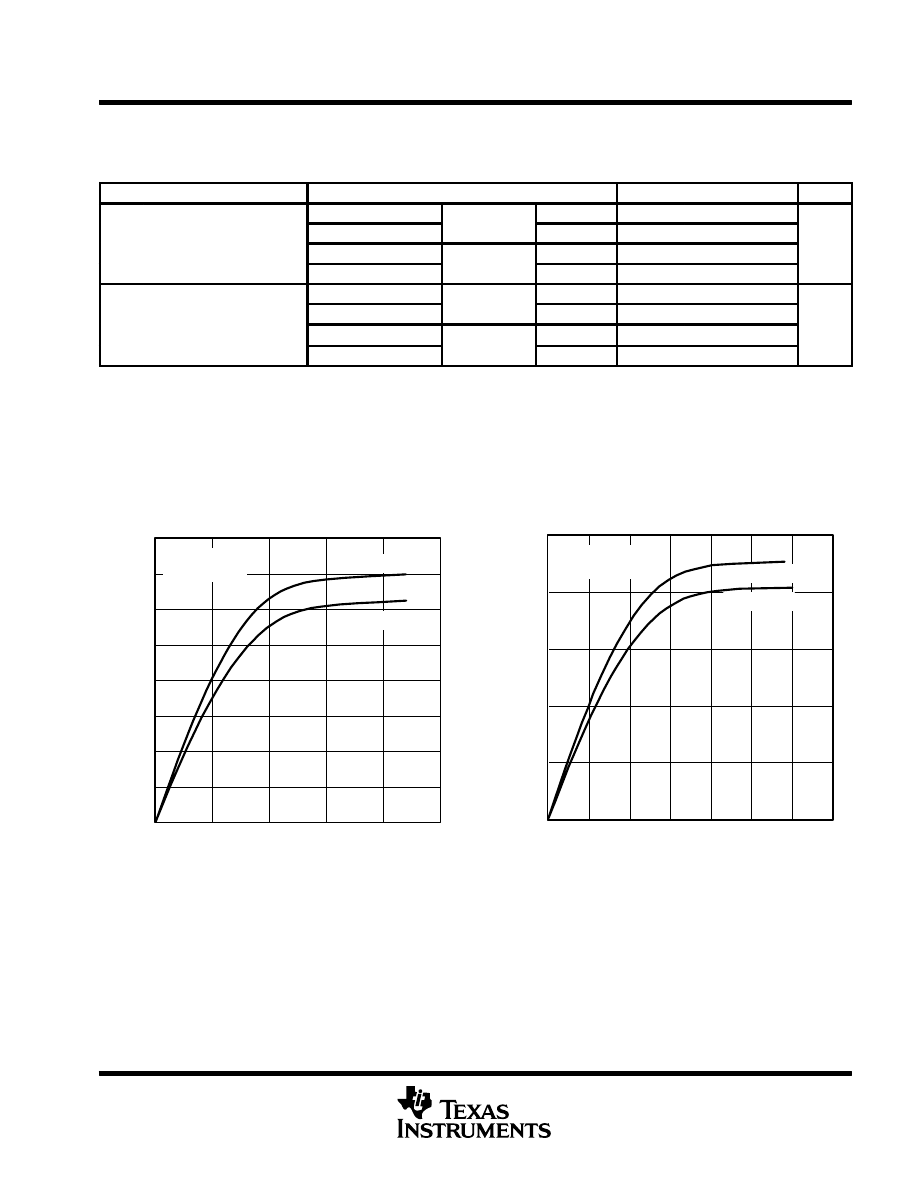
MSP430x12x
MIXED SIGNAL MICROCONTROLLER
SLAS312A – JULY 2001 – REVISED MARCH 2003
15
POST OFFICE BOX 655303
•
DALLAS, TEXAS 75265
electrical characteristics over recommended ranges of supply voltage and operating free-air
temperature (unless otherwise noted) (continued)
outputs Port 1 to P3; P1.0 to P1.7, P2.0 to P2.5, P3.0 to P3.7
PARAMETER
TEST CONDITIONS
MIN
TYP
MAX
UNIT
I(OHmax) = –1.5 mA
VCC = 2 2 V
See Note 1
VCC–0.25
VCC
VOH
High level output voltage
I(OHmax) = –6 mA
VCC = 2.2 V
See Note 2
VCC–0.6
VCC
V
VOH
High-level output voltage
I(OHmax) = –1.5 mA
VCC = 3 V
See Note 1
VCC–0.25
VCC
V
I(OHmax) = –6 mA
VCC = 3 V
See Note 2
VCC–0.6
VCC
I(OLmax) = 1.5 mA
VCC = 2 2 V
See Note 1
VSS
VSS+0.25
VOL
Low level output voltage
I(OLmax) = 6 mA
VCC = 2.2 V
See Note 2
VSS
VSS+0.6
V
VOL
Low-level output voltage
I(OLmax) = 1.5 mA
VCC = 3 V
See Note 1
VSS
VSS+0.25
V
I(OLmax) = 6 mA
VCC = 3 V
See Note 2
VSS
VSS+0.6
NOTES:
1. The maximum total current, IOHmax and IOLmax, for all outputs combined, should not exceed
±
12 mA to hold the maximum voltage
drop specified.
2. The maximum total current, IOHmax and IOLmax, for all outputs combined, should not exceed
±
48 mA to hold the maximum voltage
drop specified.
outputs – Ports P1, P2, and P3
Figure 2
VOL – Low-Level Output Voltage – V
0
4.00
8.00
12.00
16.00
20.00
24.00
28.00
32.00
0
0.5
1.0
1.5
2.0
2.5
VCC = 2.2 V
P1.0
TA = 25
°
C
TA = 85
°
C
OLI
–
T
ypical Low-Level Output Current
–
mA
TYPICAL LOW-LEVEL OUTPUT CURRENT
vs
LOW-LEVEL OUTPUT VOLTAGE
Figure 3
VOL – Low-Level Output Voltage – V
0
10
20
30
40
50
0
0.5
1.0
1.5
2.0
2.5
3.0
3.5
VCC = 3 V
P1.0
TA = 25
°
C
TA = 85
°
C
TYPICAL LOW-LEVEL OUTPUT CURRENT
vs
LOW-LEVEL OUTPUT VOLTAGE
OLI
–
T
ypical Low-Level Output Current
–
mA
NOTE: Only one output is loaded at a time.
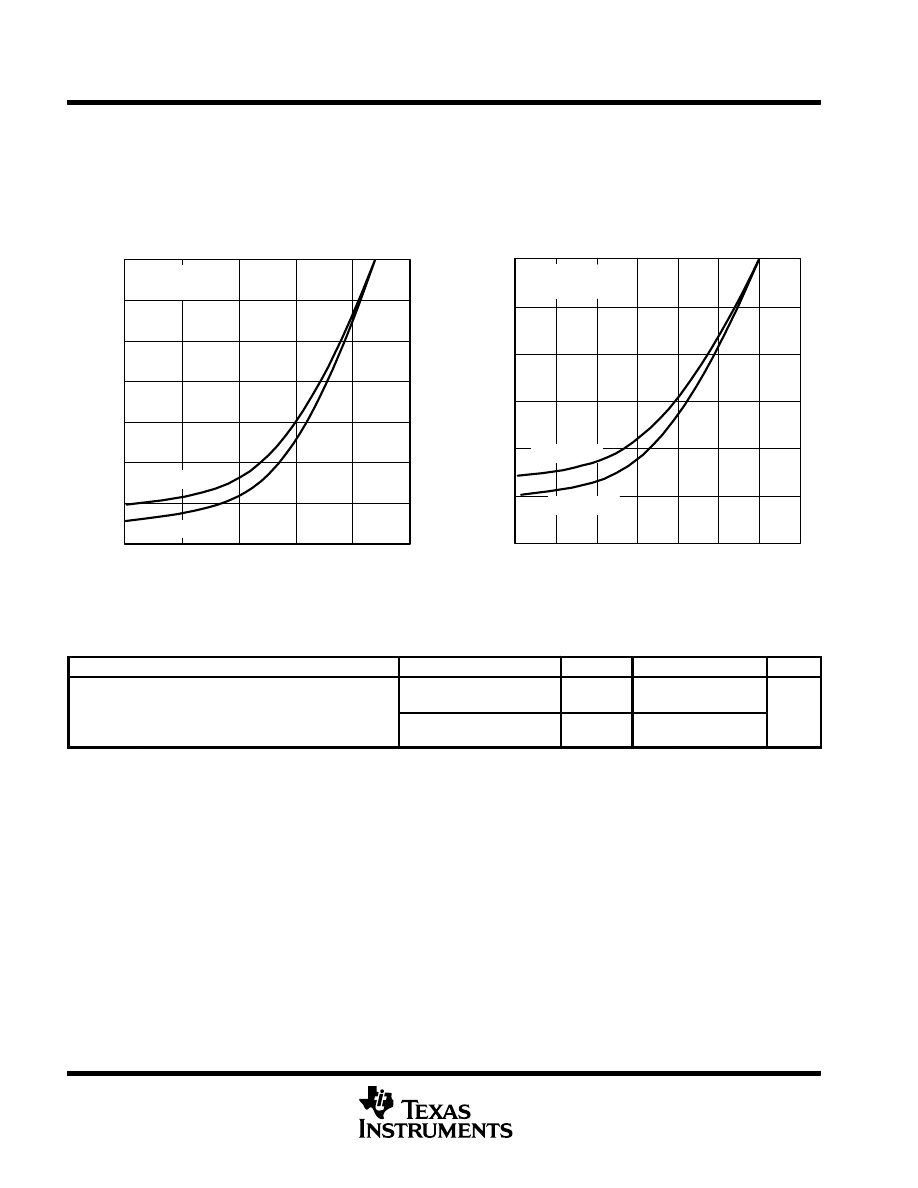
MSP430x12x
MIXED SIGNAL MICROCONTROLLER
SLAS312A – JULY 2001 – REVISED MARCH 2003
16
POST OFFICE BOX 655303
•
DALLAS, TEXAS 75265
electrical characteristics over recommended ranges of supply voltage and operating free-air
temperature (unless otherwise noted) (continued)
outputs – Ports P1, P2, and P3 (continued)
Figure 4
VOH – High-Level Output Voltage – V
–28
–24
–20
–16
–12
–8
–4
0
0
0.5
1.0
1.5
2.0
2.5
VCC = 2.2 V
P1.0
TA = 25
°
C
TA = 85
°
C
OHI
–
T
ypical High-Level Output Current
–
mA
TYPICAL HIGH-LEVEL OUTPUT CURRENT
vs
HIGH-LEVEL OUTPUT VOLTAGE
Figure 5
VOH – High-Level Output Voltage – V
–60
–50.00
–40.00
–30.00
–20.00
–10.00
0.00
0
0.5
1.0
1.5
2.0
2.5
3.0
3.5
VCC = 3 V
P1.0
TA = 25
°
C
TA = 85
°
C
TYPICAL HIGH-LEVEL OUTPUT CURRENT
vs
HIGH-LEVEL OUTPUT VOLTAGE
OHI
–
T
ypical High-Level Output Current
–
mA
NOTE: Only one output is loaded at a time.
leakage current
PARAMETER
TEST CONDITIONS
VCC
MIN
TYP
MAX
UNIT
Ilk (P
)
High impedance leakage current
Port P1: P1.x, 0
≤
× ≤
7
(see Notes 1 and 2)
2.2 V/3 V
±
50
nA
Ilkg(Px.x)
High-impedance leakage current
Port P2: P2.x, 0
≤
× ≤
5
(see Notes 1 and 2)
2.2 V/3 V
±
50
nA
NOTES:
1. The leakage current is measured with VSS or VCC applied to the corresponding pin(s), unless otherwise noted.
2. The leakage of the digital port pins is measured individually. The port pin must be selected for input and there must be no optional
pullup or pulldown resistor.
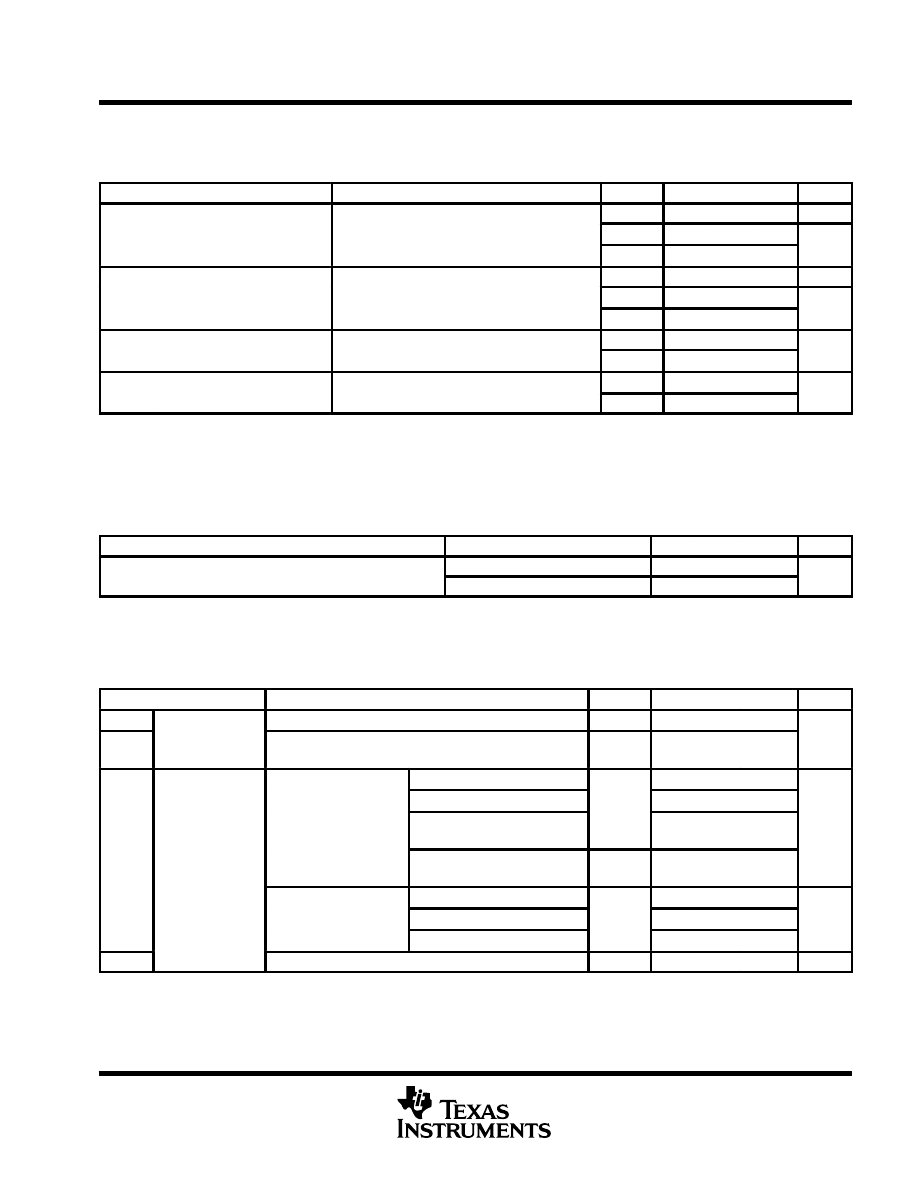
MSP430x12x
MIXED SIGNAL MICROCONTROLLER
SLAS312A – JULY 2001 – REVISED MARCH 2003
17
POST OFFICE BOX 655303
•
DALLAS, TEXAS 75265
electrical characteristics over recommended ranges of supply voltage and operating free-air
temperature (unless otherwise noted) (continued)
inputs Px.x, TAx
PARAMETER
TEST CONDITIONS
VCC
MIN
TYP
MAX
UNIT
P t P1 P2 P1
t P2
E t
l t i
i
l
2.2 V/3 V
1.5
cycle
t(int)
External interrupt timing
Port P1, P2: P1.x to P2.x, External trigger signal
for the interrupt flag, (see Note 1)
2.2 V
62
ns
(
)
for the interru t flag, (see Note 1)
3 V
50
ns
2.2 V/3 V
1.5
cycle
t(cap)
Timer_A, capture timing
TA0, TA1, TA2 (see Note 2)
2.2 V
62
ns
(
)
3 V
50
ns
f(TA t)
Timer_A clock frequency
TACLK INCLK T(H) = T(L)
2.2 V
8
MHz
f(TAext)
q
y
externally applied to pin
TACLK, INCLK T(H) = T(L)
3 V
10
MHz
f(TAint)
Timer A clock frequency
SMCLK or ACLK signal selected
2.2 V
8
MHz
f(TAint)
Timer_A clock frequency
SMCLK or ACLK signal selected
3 V
10
MHz
NOTES:
1. The external signal sets the interrupt flag every time the minimum t(int) cycle and time parameters are met. It may be set even with
trigger signals shorter than t(int). Both the cycle and timing specifications must be met to ensure the flag is set. t(int) is measured in
MCLK cycles.
2. The external capture signal triggers the capture event every time the mimimum t(cap) cycle and time parameters are met. A capture
may be triggered with capture signals even shorter than t(cap). Both the cycle and timing specifications must be met to ensure a
correct capture of the 16-bit timer value and to ensure the flag is set.
USART (see Note 1)
PARAMETER
TEST CONDITIONS
MIN
TYP
MAX
UNIT
t( )
USART: deglitch time
VCC = 2.2 V
200
430
800
ns
t(
τ
)
USART: deglitch time
VCC = 3 V
150
280
500
ns
NOTE 1: The signal applied to the USART receive signal/terminal (URXD) should meet the timing requirements of t(
τ
) to ensure that the URXS
flip-flop is set. The URXS flip-flop is set with negative pulses meeting the minimum-timing condition of t(
τ
). The operating conditions to
set the flag must be met independently from this timing constraint. The deglitch circuitry is active only on negative transitions on the
URXD line.
outputs P1.x, P2.x, P3.x, TAx
PARAMETER
TEST CONDITIONS
VCC
MIN
TYP
MAX
UNIT
f(P20)
P2.0/ACLK,
CL = 20 pF
2.2 V/3 V
fSystem
f(TAx)
Output frequency
TA0, TA1, TA2,
CL = 20 pF,
Internal clock source, SMCLK signal applied (see Note 1)
2.2 V/3 V
dc
fSystem
MHz
fSMCLK = fLFXT1 = fXT1
40%
60%
P1 4/SMCLK
fSMCLK = fLFXT1 = fLF
2.2 V/3 V
35%
65%
P1.4/SMCLK,
CL = 20 pF
fSMCLK = fLFXT1/n
2.2 V/3 V
50%–
15 ns
50%
50%+
15 ns
t(Xdc)
Duty cycle of O/P
frequency
fSMCLK = fDCOCLK
2.2 V/3 V
50%–
15 ns
50%
50%+
15 ns
P2 0/ACLK
fP20 = fLFXT1 = fXT1
40%
60%
P2.0/ACLK,
CL = 20 pF
fP20 = fLFXT1 = fLF
2.2 V/3 V
30%
70%
CL 20 F
fP20 = fLFXT1/n
50%
t(TAdc)
TA0, TA1, TA2,
CL = 20 pF, Duty cycle = 50%
2.2 V/3 V
0
±
50
ns
NOTE 1: The limits of the system clock MCLK has to be met. MCLK and SMCLK can have different frequencies.
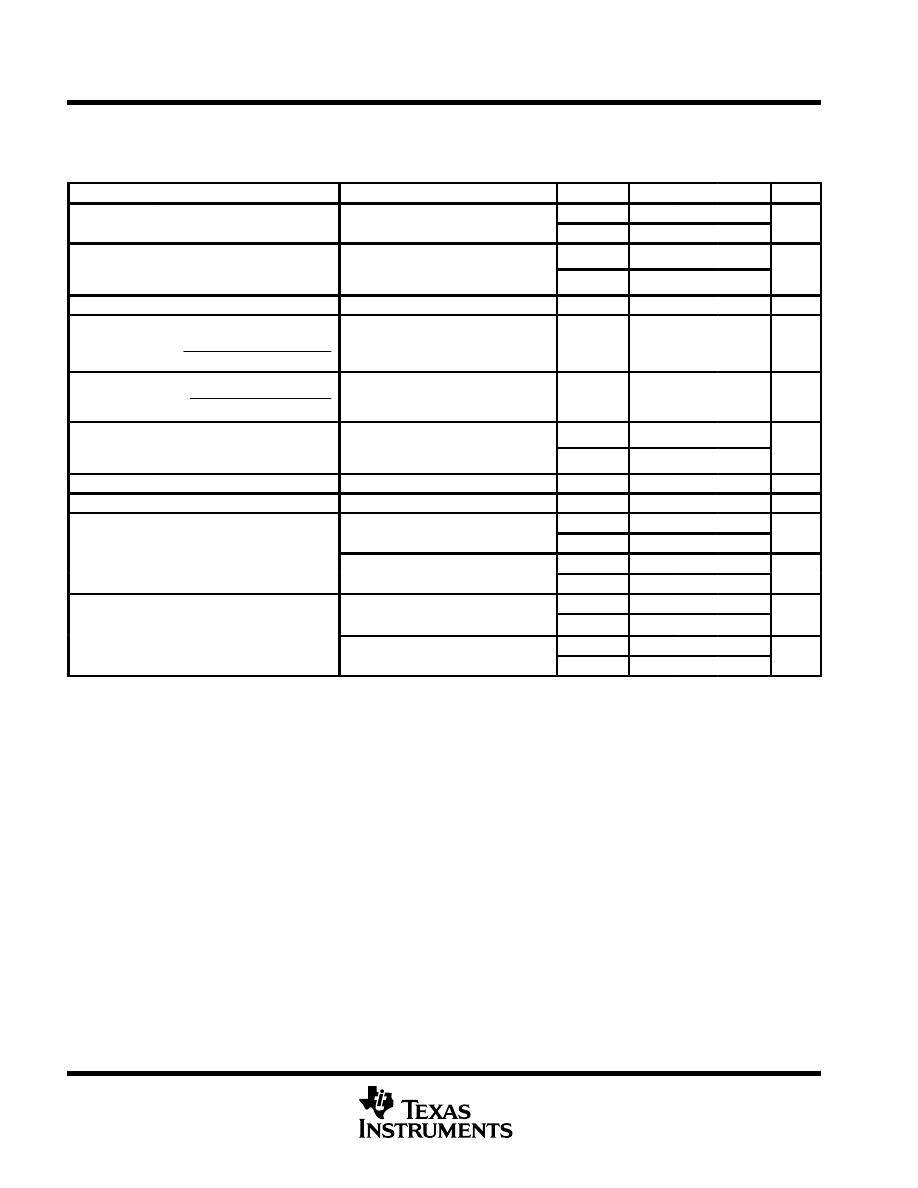
MSP430x12x
MIXED SIGNAL MICROCONTROLLER
SLAS312A – JULY 2001 – REVISED MARCH 2003
18
POST OFFICE BOX 655303
•
DALLAS, TEXAS 75265
electrical characteristics over recommended ranges of supply voltage and operating free-air
temperature (unless otherwise noted) (continued)
Comparator_A (see Note 1)
PARAMETER
TEST CONDITIONS
VCC
MIN
TYP
MAX
UNIT
I(DD)
CAON=1
CARSEL=0
CAREF=0
2.2 V
25
40
µ
A
I(DD)
CAON=1, CARSEL=0, CAREF=0
3 V
45
60
µ
A
I(Refladder/
CAON=1, CARSEL=0,
CAREF=1/2/3
No load at
2.2 V
30
50
µ
A
(Refladder/
RefDiode)
CAREF=1/2/3, No load at
P2.3/CA0/TA1 and P2.4/CA1/TA2
3 V
45
71
µ
A
V(IC)
Common-mode input voltage
CAON =1
2.2 V/3 V
0
VCC–1
V
V(Ref025)
Voltage at 0.25 V
CC
node
V
CC
PCA0=1, CARSEL=1, CAREF=1,
No load at P2.3/CA0/TA1 and
P2.4/CA1/TA2
2.2 V/3 V
0.23
0.24
0.25
V(Ref050)
Voltage at 0.5 V
CC
node
V
CC
PCA0=1, CARSEL=1, CAREF=2,
No load at P2.3/CA0/TA1 and
P2.4/CA1/TA2
2.2 V/3 V
0.47
0.48
0.5
V(R fVT)
PCA0=1, CARSEL=1, CAREF=3,
No load at P2 3/CA0/TA1 and
2.2 V
390
480
540
mV
V(RefVT)
No load at P2.3/CA0/TA1 and
P2.4/CA1/TA2, TA = 85
°
C
3 V
400
490
550
mV
V(offset)
Offset voltage
See Note 2
2.2 V/3 V
–30
30
mV
Vhys
Input hysteresis
CAON=1
2.2 V/3 V
0
0.7
1.4
mV
TA = 25
°
C, Overdrive 10 mV, Without
2.2 V
160
210
300
ns
t(
LH)
A
filter: CAF=0
3 V
80
150
240
ns
t(response LH)
TA = 25
°
C, Overdrive 10 mV, With fil-
2.2 V
1.4
1.9
3.4
µ
s
A
ter: CAF=1
3 V
0.9
1.5
2.6
µ
s
TA = 25
°
C,
2.2 V
130
210
300
ns
t(response HL)
A
Overdrive 10 mV, without filter: CAF=0
3 V
80
150
240
ns
t(response HL)
TA = 25
°
C,
2.2 V
1.4
1.9
3.4
µ
s
A
Overdrive 10 mV, with filter: CAF=1
3 V
0.9
1.5
2.6
µ
s
NOTES:
1. The leakage current for the Comparator_A terminals is identical to Ilkg(Px.x) specification.
2. The input offset voltage can be cancelled by using the CAEX bit to invert the Comparator_A inputs on successive measurements.
The two successive measurements are then summed together.
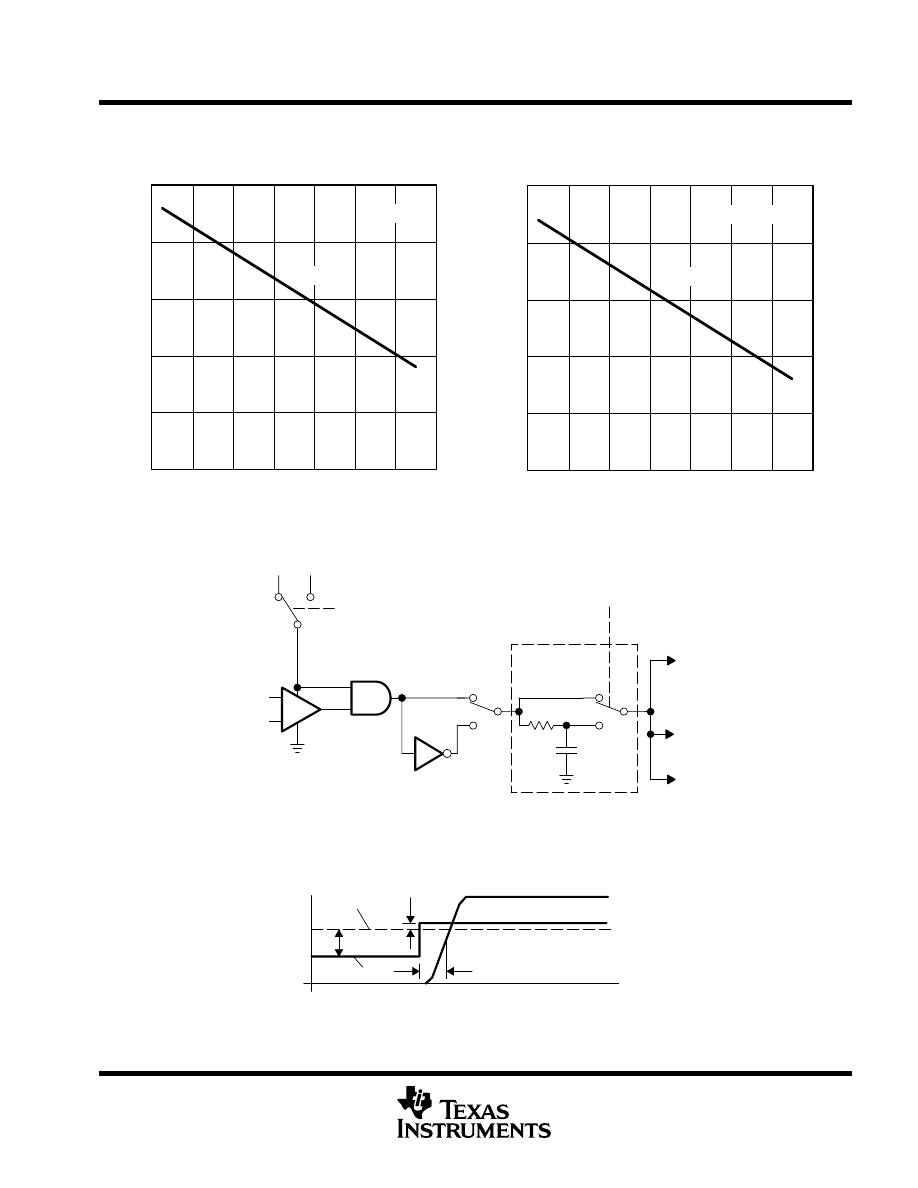
MSP430x12x
MIXED SIGNAL MICROCONTROLLER
SLAS312A – JULY 2001 – REVISED MARCH 2003
19
POST OFFICE BOX 655303
•
DALLAS, TEXAS 75265
electrical characteristics over recommended operating free-air temperature (unless otherwise
noted) (continued)
TA – Free-Air Temperature –
°
C
400
450
500
550
600
650
–45
–25
–5
15
35
55
75
95
VCC = 3 V
Figure 6. V
(RefVT)
vs Temperature, V
CC
= 3 V
V
(REFVT)
–
Reference V
olts
–
mV
Typical
Figure 7. V
(RefVT)
vs Temperature, V
CC
= 2.2 V
TA – Free-Air Temperature –
°
C
400
450
500
550
600
650
–45
–25
–5
15
35
55
75
95
VCC = 2.2 V
V
(REFVT)
–
Reference V
olts
–
mV
Typical
_
+
CAON
0
1
V+
0
1
CAF
Low Pass Filter
τ
≈
2.0
µ
s
To Internal
Modules
Set CAIFG
Flag
CAOUT
V–
VCC
1
0 V
0
Figure 8. Block Diagram of Comparator_A Module
Overdrive
VCAOUT
t(response)
V+
V–
400 mV
Figure 9. Overdrive Definition
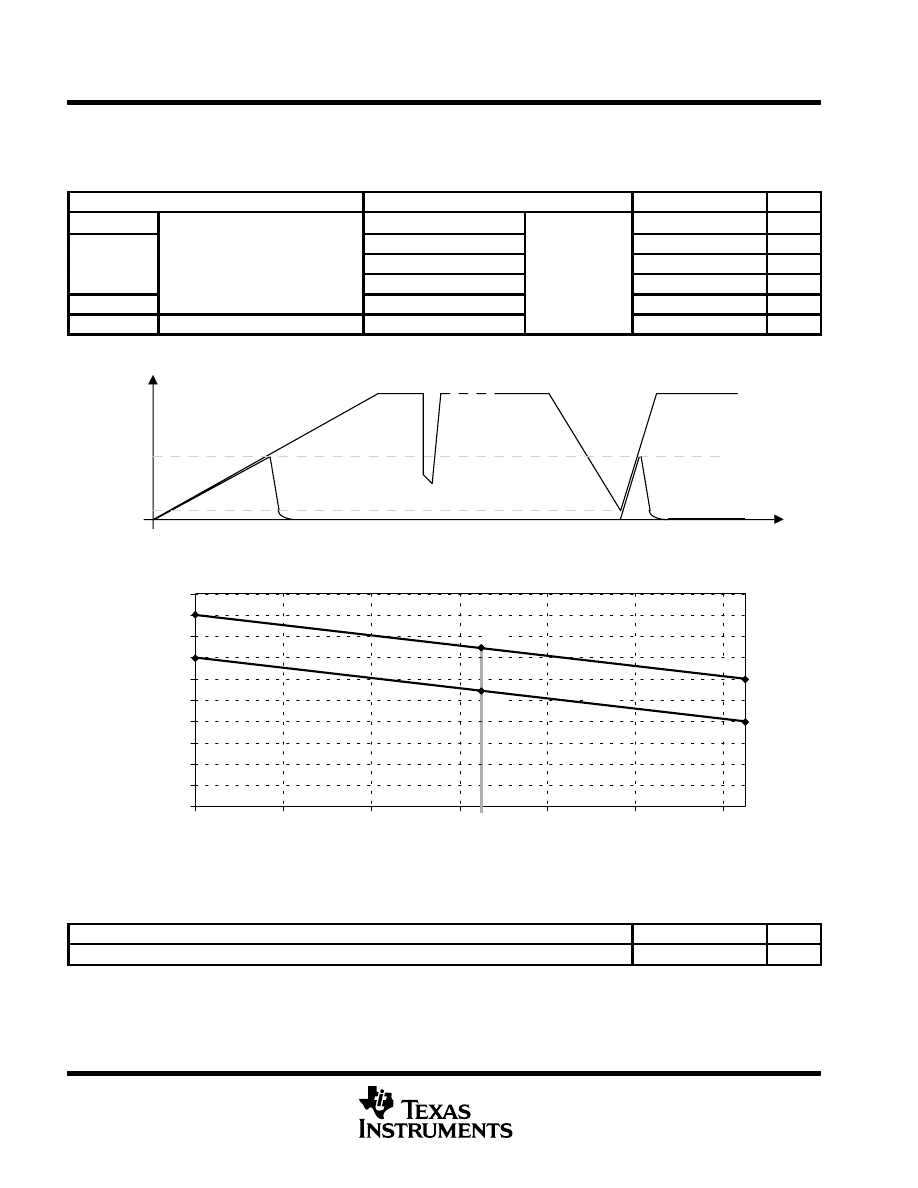
MSP430x12x
MIXED SIGNAL MICROCONTROLLER
SLAS312A – JULY 2001 – REVISED MARCH 2003
20
POST OFFICE BOX 655303
•
DALLAS, TEXAS 75265
electrical characteristics over recommended ranges of supply voltage and operating free-air
temperature (unless otherwise noted) (continued)
PUC/POR
PARAMETER
TEST CONDITIONS
MIN
TYP
MAX
UNIT
t(POR_Delay)
150
250
µ
s
TA = –40
°
C
1.4
1.8
V
VPOR
POR
TA = 25
°
C
VCC = 2 2 V/3 V
1.1
1.5
V
TA = 85
°
C
VCC = 2.2 V/3 V
0.8
1.2
V
V(min)
0
0.4
V
t(reset)
PUC/POR
Reset is accepted internally
2
µ
s
VCC
POR
V
t
V
POR
V
(min)
POR
No POR
Figure 10. Power-On Reset (POR) vs Supply Voltage
0
0.2
0.6
1.0
1.2
1.8
2.0
–40
–20
0
20
40
60
80
Temperature [
°
C]
V [V]
1.6
1.4
0.8
0.4
1.2
1.5
1.8
0.8
1.1
1.4
25
°
C
Max
Min
POR
Figure 11. V
POR
vs Temperature
RAM
PARAMETER
MIN
NOM
MAX
UNIT
V(RAMh)
CPU halted (see Note 1)
1.6
V
NOTE 1: This parameter defines the minimum supply voltage VCC when the data in the program memory RAM remains unchanged. No program
execution should happen during this supply voltage condition.
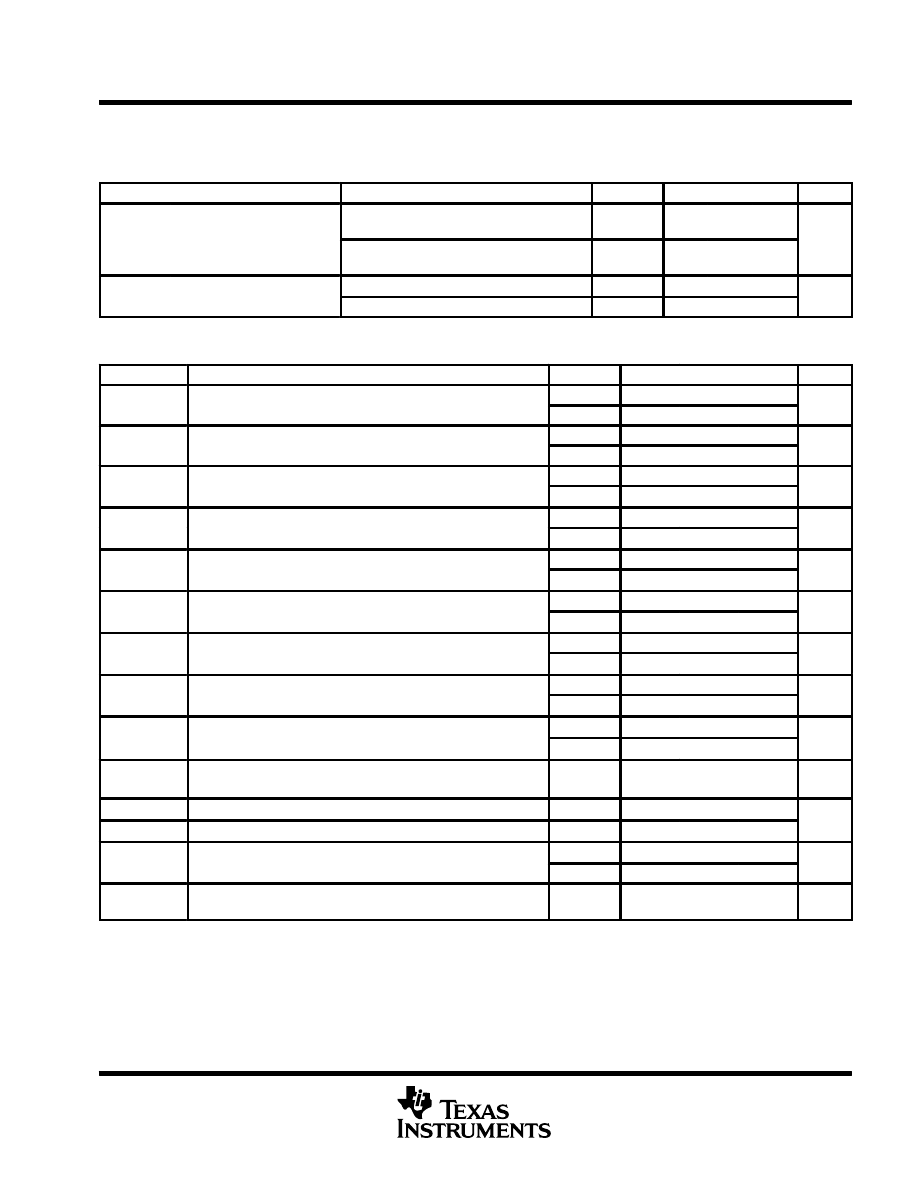
MSP430x12x
MIXED SIGNAL MICROCONTROLLER
SLAS312A – JULY 2001 – REVISED MARCH 2003
21
POST OFFICE BOX 655303
•
DALLAS, TEXAS 75265
electrical characteristics over recommended ranges of supply voltage and operating free-air
temperature (unless otherwise noted) (continued)
crystal oscillator,LFXT1
PARAMETER
TEST CONDITIONS
VCC
MIN
TYP
MAX
UNIT
C(XIN)
Input capacitance
XTS=0; LF mode selected
2.2 V / 3 V
12
pF
C(XIN)
Input capacitance
XTS=1; XT1 mode selected (see Note 1)
2.2 V / 3 V
2
pF
C(XOUT)
Output capacitance
XTS=0; LF mode selected
2.2 V / 3 V
12
pF
C(XOUT)
Out ut ca acitance
XTS=1; XT1 mode selected (see Note 1)
2.2 V / 3 V
2
F
NOTE 1: Requires external capacitors at both terminals. Values are specified by crystal manufacturers.
DCO
PARAMETER
TEST CONDITIONS
VCC
MIN
TYP
MAX
UNIT
f(DCO03)
R
l = 0 DCO = 3 MOD = 0 DCOR = 0
TA = 25
°
C
2.2 V
0.08
0.12
0.15
MHz
f(DCO03)
Rsel = 0, DCO = 3, MOD = 0, DCOR = 0, TA = 25
°
C
3 V
0.08
0.13
0.16
MHz
f(DCO13)
R
l = 1 DCO = 3 MOD = 0 DCOR = 0
TA = 25
°
C
2.2 V
0.14
0.19
0.23
MHz
f(DCO13)
Rsel = 1, DCO = 3, MOD = 0, DCOR = 0, TA = 25
°
C
3 V
0.14
0.18
0.22
MHz
f(DCO23)
R
l = 2 DCO = 3 MOD = 0 DCOR = 0
TA = 25
°
C
2.2 V
0.22
0.30
0.36
MHz
f(DCO23)
Rsel = 2, DCO = 3, MOD = 0, DCOR = 0, TA = 25
°
C
3 V
0.22
0.28
0.34
MHz
f(DCO33)
R
l = 3 DCO = 3 MOD = 0 DCOR = 0
TA = 25
°
C
2.2 V
0.37
0.49
0.59
MHz
f(DCO33)
Rsel = 3, DCO = 3, MOD = 0, DCOR = 0, TA = 25
°
C
3 V
0.37
0.47
0.56
MHz
f(DCO43)
R
l = 4 DCO = 3 MOD = 0 DCOR = 0
TA = 25
°
C
2.2 V
0.61
0.77
0.93
MHz
f(DCO43)
Rsel = 4, DCO = 3, MOD = 0, DCOR = 0, TA = 25
°
C
3 V
0.61
0.75
0.9
MHz
f(DCO53)
R
l = 5 DCO = 3 MOD = 0 DCOR = 0
TA = 25
°
C
2.2 V
1
1.2
1.5
MHz
f(DCO53)
Rsel = 5, DCO = 3, MOD = 0, DCOR = 0, TA = 25
°
C
3 V
1
1.3
1.5
MHz
f(DCO63)
R
l = 6 DCO = 3 MOD = 0 DCOR = 0
TA = 25
°
C
2.2 V
1.6
1.9
2.2
MHz
f(DCO63)
Rsel = 6, DCO = 3, MOD = 0, DCOR = 0, TA = 25
°
C
3 V
1.69
2
2.29
MHz
f(DCO73)
R
l = 7 DCO = 3 MOD = 0 DCOR = 0
TA = 25
°
C
2.2 V
2.4
2.9
3.4
MHz
f(DCO73)
Rsel = 7, DCO = 3, MOD = 0, DCOR = 0, TA = 25
°
C
3 V
2.7
3.2
3.65
MHz
f(DCO77)
Rsel = 7 DCO = 7 MOD = 0 DCOR = 0
TA = 25
°
C
2.2 V
4
4.5
4.9
MHz
f(DCO77)
Rsel = 7, DCO = 7, MOD = 0, DCOR = 0, TA = 25
°
C
3 V
4.4
4.9
5.4
MHz
f(DCO47)
R
l = 4 DCO = 7 MOD = 0 DCOR = 0
TA = 25
°
C
2 2 V/3 V
FDCO40 FDCO40 FDCO40
MHz
f(DCO47)
Rsel = 4, DCO = 7, MOD = 0, DCOR = 0, TA = 25
°
C
2.2 V/3 V
DCO40
x1.7
DCO40
x2.1
DCO40
x2.5
MHz
S(Rsel)
SR = fRsel+1/fRsel
2.2 V/3 V
1.35
1.65
2
ratio
S(DCO)
SDCO = fDCO+1/fDCO
2.2 V/3 V
1.07
1.12
1.16
ratio
Dt
Temperature drift R
l = 4 DCO = 3 MOD = 0 (see Note 1)
2.2 V
–0.31
–0.36
–0.40
%/
°
C
Dt
Temperature drift, Rsel = 4, DCO = 3, MOD = 0 (see Note 1)
3 V
–0.33
–0.38
–0.43
%/
°
C
DV
Drift with VCC variation, Rsel = 4, DCO = 3, MOD = 0
(see Note 1)
2.2 V/3 V
0
5
10
%/V
NOTES:
1. These parameters are not production tested.
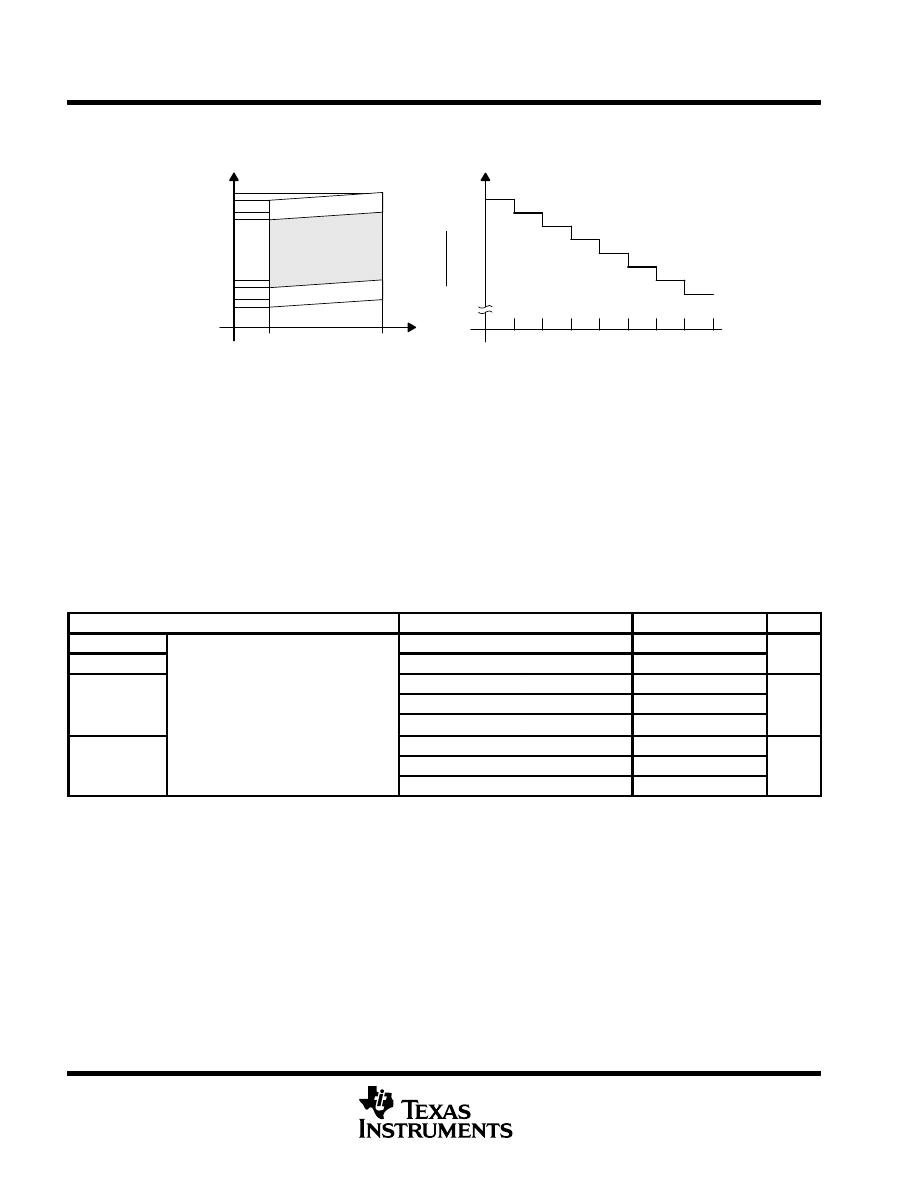
MSP430x12x
MIXED SIGNAL MICROCONTROLLER
SLAS312A – JULY 2001 – REVISED MARCH 2003
22
POST OFFICE BOX 655303
•
DALLAS, TEXAS 75265
electrical characteristics over recommended ranges of supply voltage and operating free-air
temperature (unless otherwise noted) (continued)
ÎÎÎÎÎÎ
ÎÎÎÎÎÎ
ÎÎÎÎÎÎ
ÎÎÎÎÎÎ
2.2 V
3 V
VCC
Max
Min
Max
Min
f(DCOx7)
f(DCOx0)
Frequency V
ariance
0
1
2
3
4
5
6
7
DCO Steps
1
f DCOCLK
Figure 12. DCO Characteristics
principle characteristics of the DCO
D
Individual devices have a minimum and maximum operation frequency. The specified parameters for
f
DCOx0
to f
DCOx7
are valid for all devices
D
The DCO control bits DCO0, DCO1 and DCO2 have a step size as defined in parameter S
DCO
.
D
The modulation control bits MOD0 to MOD4 select how often f
DCO+1
is used within the period of 32 DCOCLK
cycles. f
DCO
is used for the remaining cycles. The frequency is an average = f
DCO
×
(2
MOD/32
).
D
All ranges selected by R
sel(n)
overlap with R
sel(n+1)
: R
sel0
overlaps with R
sel1
, ... R
sel6
overlaps with R
sel7
.
wake-up from lower power modes (LPMx)
PARAMETER
TEST CONDITIONS
MIN
TYP
MAX
UNIT
t(LPM0)
VCC = 2.2 V/3 V
100
ns
t(LPM2)
VCC = 2.2 V/3 V
100
ns
f(MCLK) = 1 MHz,
VCC = 2.2 V/3 V
6
t(LPM3)
Delay time (see Note 1)
f(MCLK) = 2 MHz,
VCC = 2.2 V/3 V
6
µ
s
(
)
Delay time (see Note 1)
f(MCLK) = 3 MHz,
VCC = 2.2 V/3 V
6
f(MCLK) = 1 MHz,
VCC = 2.2 V/3 V
6
t(LPM4)
f(MCLK) = 2 MHz,
VCC = 2.2 V/3 V
6
µ
s
(
)
f(MCLK) = 3 MHz,
VCC = 2.2 V/3 V
6
NOTE 1: Parameter applicable only if DCOCLK is used for MCLK.
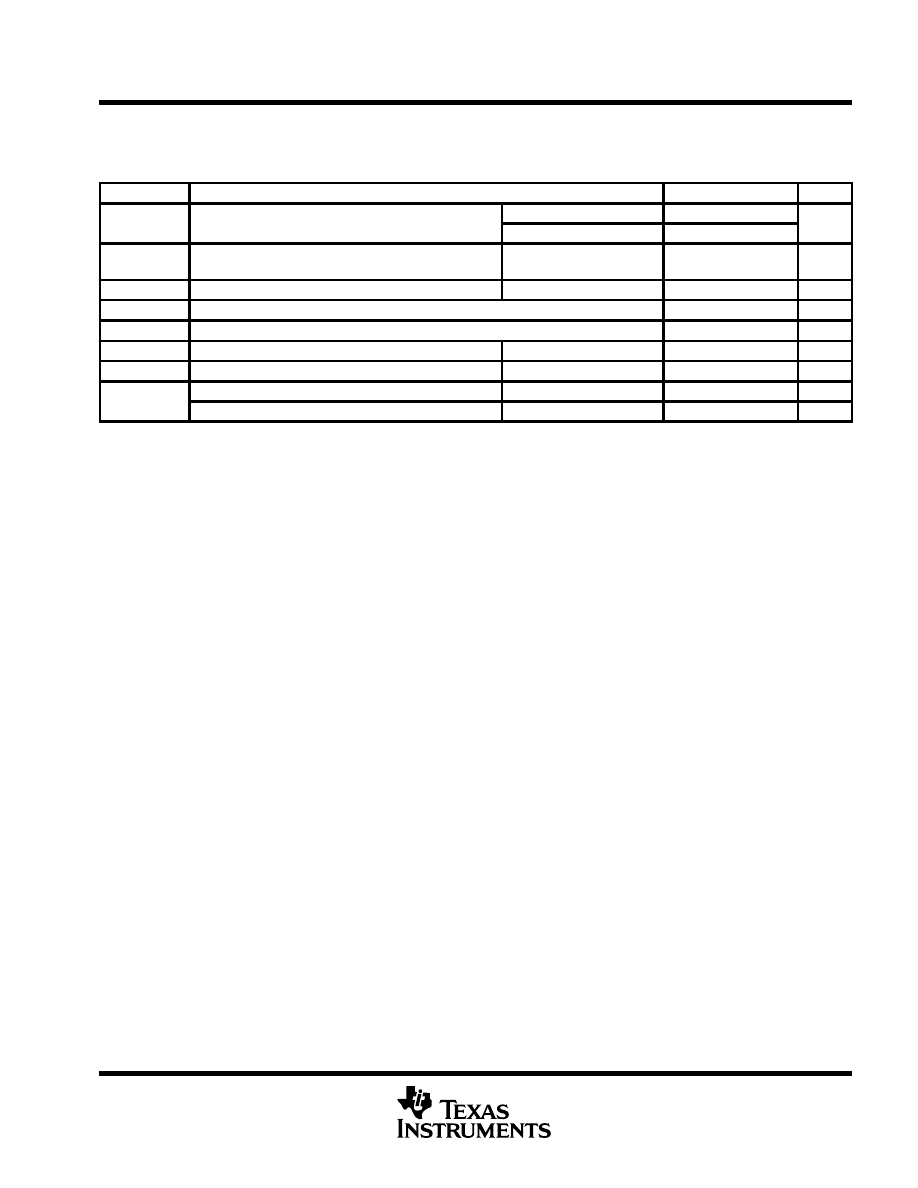
MSP430x12x
MIXED SIGNAL MICROCONTROLLER
SLAS312A – JULY 2001 – REVISED MARCH 2003
23
POST OFFICE BOX 655303
•
DALLAS, TEXAS 75265
electrical characteristics over recommended ranges of supply voltage and operating free-air
temperature (unless otherwise noted) (continued)
JTAG, program memory and fuse
PARAMETER
TEST CONDITIONS
MIN
TYP
MAX
UNIT
f(TCK)
TCK frequency JTAG/test (see Note 3)
VCC = 2.2 V
dc
5
MHz
f(TCK)
TCK frequency, JTAG/test (see Note 3)
VCC = 3 V
dc
10
MHz
VCC(FB)
Supply voltage during fuse-blow condition,
T(A) = 25
°
C
2.5
V
V(FB)
Fuse blow voltage (see Notes 1 and 2)
6
7
V
I(FB)
Supply current on TEST during fuse blow (see Note 2)
100
mA
t(FB)
Time to blow the fuse (see Note 2)
1
ms
I(DD-PGM)
Current during program cycle (see Note 4)
VCC = 2.7 V/3.6 V
3
5
mA
I(DD-ERASE)
Current during erase cycle (see Note 4)
VCC = 2.7 V/3.6 V
3
7
mA
t( t ti )
Write/erase cycles
10
4
10
5
t(retention)
Data retention TJ = 25
°
C
100
Year
NOTES:
1. The power source to blow the fuse is applied to TEST pin.
2. Once the JTAG fuse is blown, no further access to the MSP430 JTAG/test feature is possible. The JTAG block is switched to bypass
mode.
3. f(TCK) may be restricted to meet the timing requirements of the module selected.
4. f(TCK) may be restricted to meet the timing requirements of the module selected. Duration of the program/erase cycle is determined
by f(FTG) applied to the flash timing controller. It can be calculated as follows:
t(word write) = 35
1/f(FTG)
t(block write, byte 0) = 30
1/f(FTG)
t(block write, bytes 1–63) = 20
1/f(FTG)
t(block write end sequence) = 6
1/f(FTG)
t(mass erase) = 5297
1/f(FTG)
t(segment erase) = 4819
1/f(FTG)
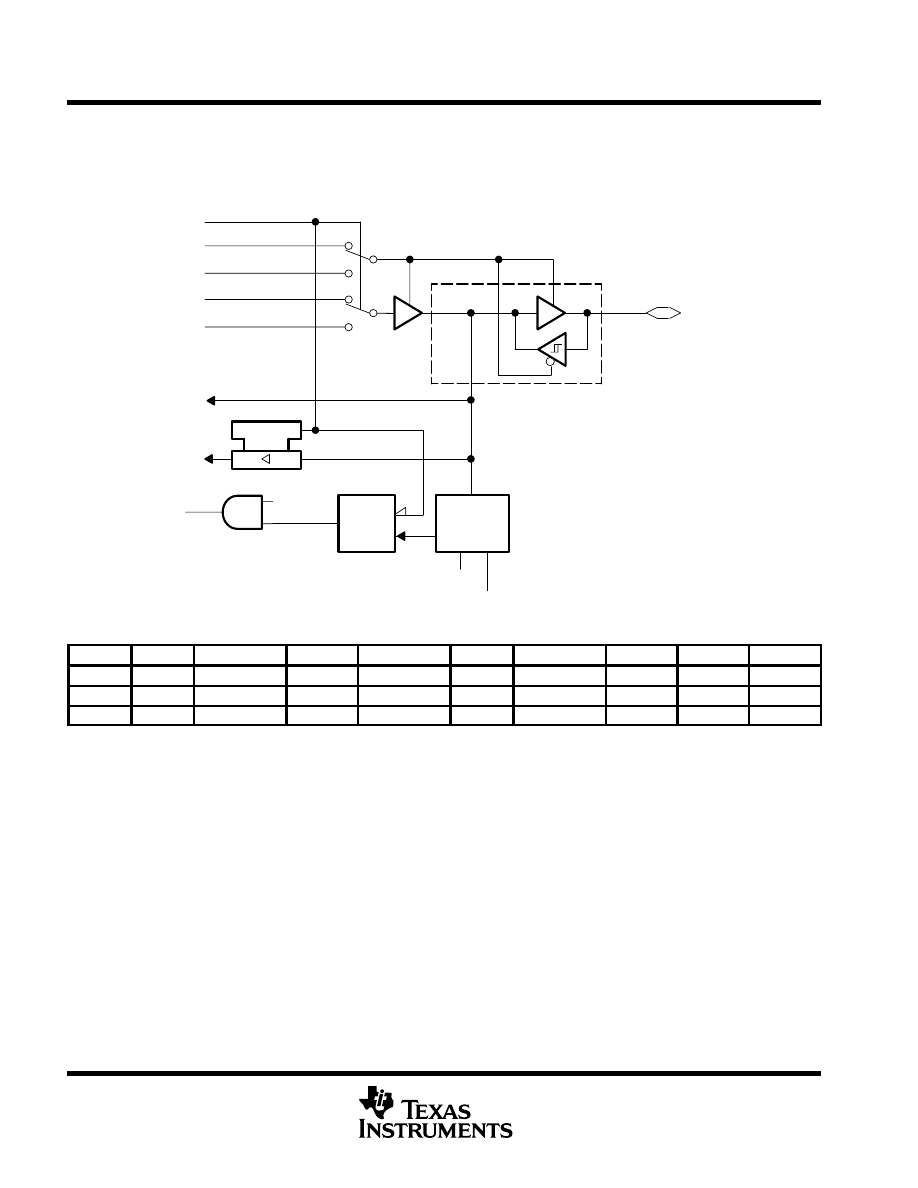
MSP430x12x
MIXED SIGNAL MICROCONTROLLER
SLAS312A – JULY 2001 – REVISED MARCH 2003
24
POST OFFICE BOX 655303
•
DALLAS, TEXAS 75265
APPLICATION INFORMATION
input/output schematic
Port P1, P1.0 to P1.3, input/output with Schmitt-trigger
EN
D
P1.0/TACLK
P1.1/TA0
P1.2/TA1
P1.3/TA2
0
1
0
1
Interrupt
Edge
Select
EN
Set
Q
P1IE.x
P1IFG.x
P1IRQ.x
Interrupt
Flag
P1IES.x
P1SEL.x
Module X IN
P1IN.x
P1OUT.x
Module X OUT
Direction Control
From Module
P1DIR.x
P1SEL.x
Pad Logic
NOTE: x = Bit/identifier, 0 to 3 for port P1
P1Sel.0
P1DIR.0
P1DIR.0
P1OUT.0
VSS
P1IN.0
TACLK†
P1IE.0
P1IFG.0
P1IES.0
P1Sel.1
P1DIR.1
P1DIR.1
P1OUT.1
Out0 signal†
P1IN.1
CCI0A†
P1IE.1
P1IFG.1
P1IES.1
P1Sel.2
P1DIR.2
P1DIR.2
P1OUT.2
Out1 signal†
P1IN.2
CCI1A†
P1IE.2
P1IFG.2
P1IES.2
P1Sel.3
P1DIR.3
P1DIR.3
P1OUT.3
Out2 signal†
P1IN.3
CCI2A†
P1IE.3
P1IFG.3
P1IES.3
† Signal from or to Timer_A
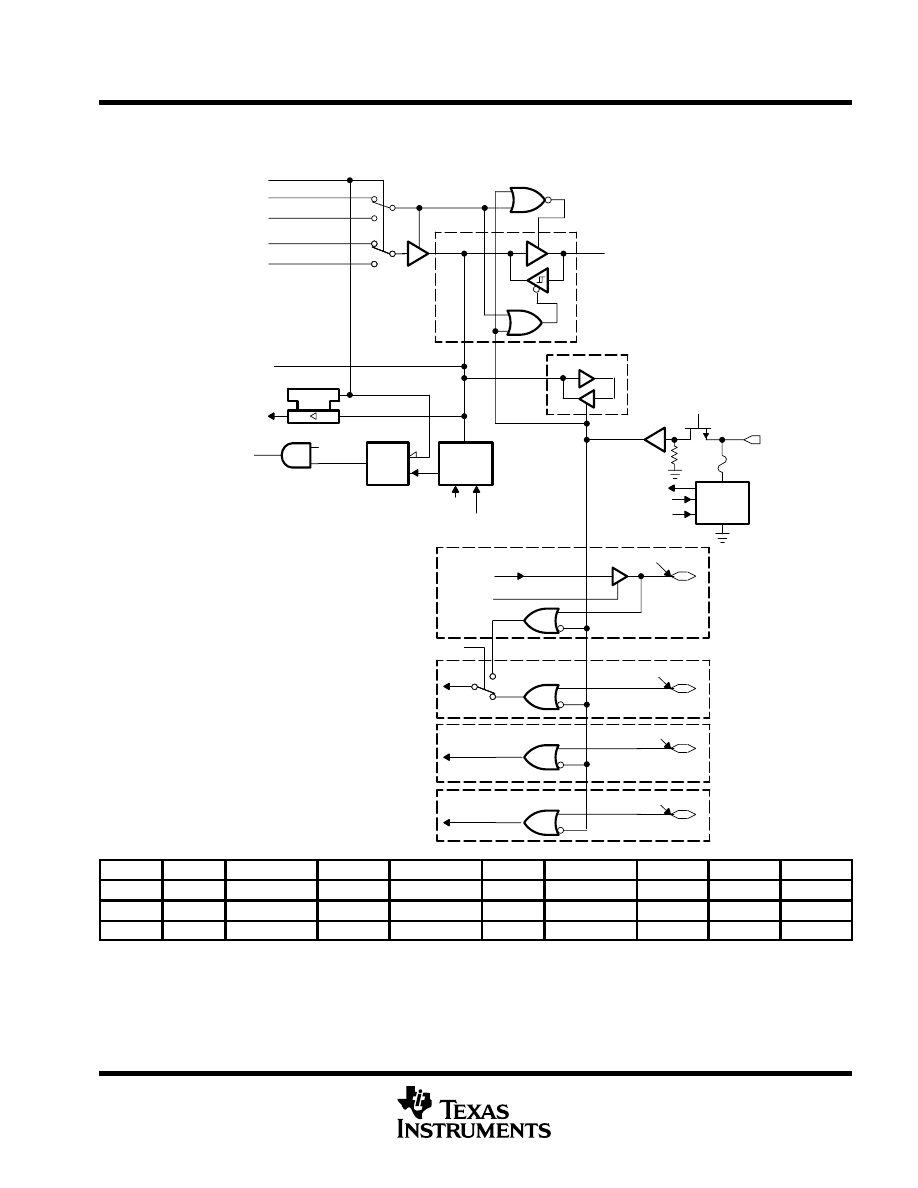
MSP430x12x
MIXED SIGNAL MICROCONTROLLER
SLAS312A – JULY 2001 – REVISED MARCH 2003
25
POST OFFICE BOX 655303
•
DALLAS, TEXAS 75265
APPLICATION INFORMATION
Port P1, P1.4 to P1.7, input/output with Schmitt-trigger and in-system access features
EN
D
P1.4–P1.7
0
1
0
1
Interrupt
Edge
Select
EN
Set
Q
P1IE.x
P1IFG.x
P1IRQ.x
Interrupt
Flag
P1IES.x
P1SEL.x
Module X IN
P1IN.x
P1OUT.x
Module X OUT
Direction Control
From Module
P1DIR.x
P1SEL.x
Pad Logic
Bus Keeper
60 k
Ω
Control by
JTAG
0
1
TDO
Controlled By JTAG
P1.x
TDI
P1.x
TST
TMS
TST
TCK
TST
Controlled by JTAG
TST
P1.x
P1.x
NOTE: The test pin should be protected from potential EMI
and ESD voltage spikes. This may require a smaller
external pulldown resistor in some applications.
x = Bit identifier, 4 to 7 for port P1
During programming activity and during blowing
the fuse, the pin TDO/TDI is used to apply the test
input for JTAG circuitry.
P1.7/TA2/TDO/TDI
P1.6/TA1/TDI
P1.5/TA0/TMS
P1.4/SMCLK/TCK
Typical
TEST
Bum
and
Test Fuse
DVCC
P1Sel.4
P1DIR.4
P1DIR.4
P1OUT.4
SMCLK
P1IN.4
unused
P1IE.4
P1IFG.4
P1IES.4
P1Sel.5
P1DIR.5
P1DIR.5
P1OUT.5
Out0 signal†
P1IN.5
unused
P1IE.5
P1IFG.5
P1IES.5
P1Sel.6
P1DIR.6
P1DIR.6
P1OUT.6
Out1 signal†
P1IN.6
unused
P1IE.6
P1IFG.6
P1IES.6
P1Sel.7
P1DIR.7
P1DIR.7
P1OUT.7
Out2 signal†
P1IN.7
unused
P1IE.7
P1IFG.7
P1IES.7
† Signal from or to Timer_A
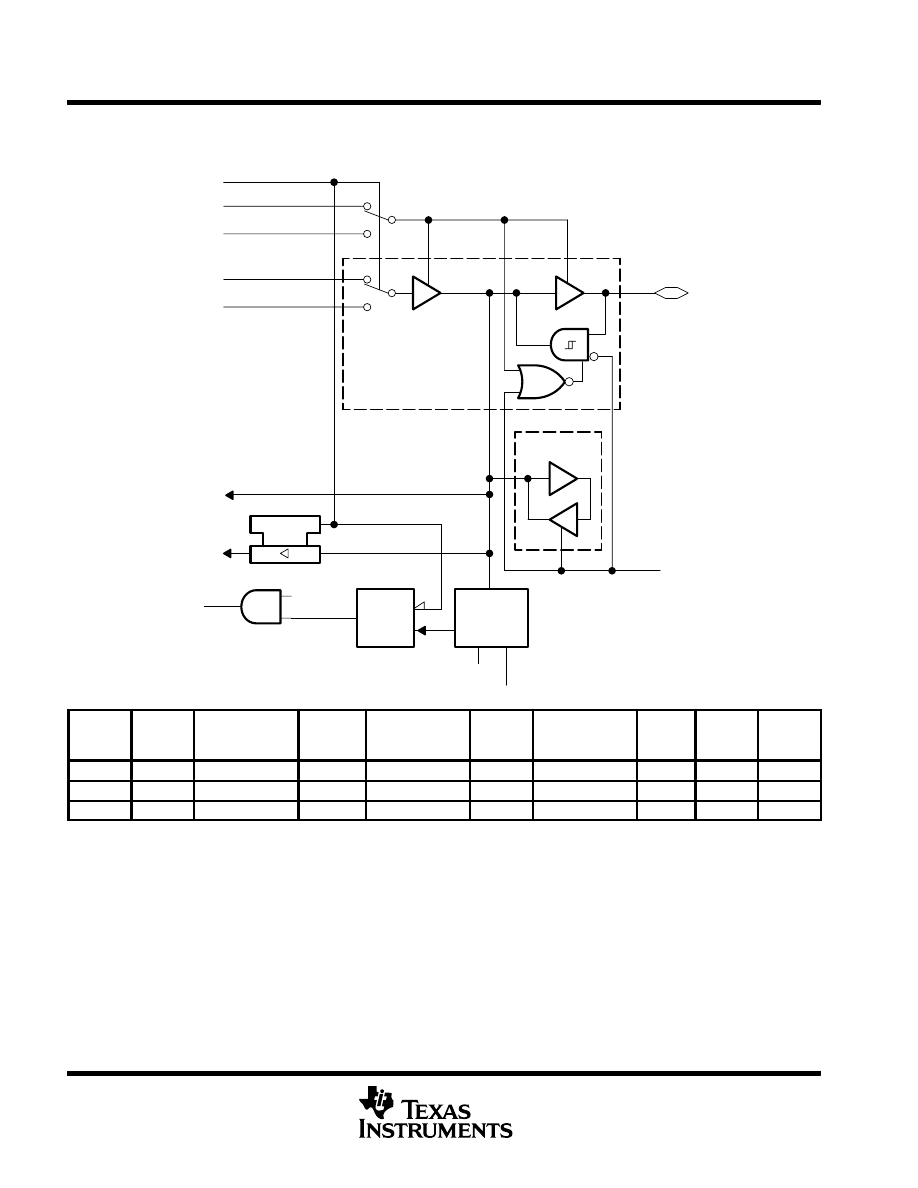
MSP430x12x
MIXED SIGNAL MICROCONTROLLER
SLAS312A – JULY 2001 – REVISED MARCH 2003
26
POST OFFICE BOX 655303
•
DALLAS, TEXAS 75265
APPLICATION INFORMATION
Port P2, P2.0 to P2.2, input/output with Schmitt-trigger
EN
D
P2.0/ACLK
P2.1/INCLK
P2.2/CAOUT/TA0
0
1
0
1
Interrupt
Edge
Select
EN
Set
Q
P2IE.x
P2IFG.x
P2IRQ.x
Interrupt
Flag
P2IES.x
P2SEL.x
Module X IN
P2IN.x
P2OUT.x
Module X OUT
Direction Control
From Module
P2DIR.x
P2SEL.x
Pad Logic
NOTE: x = Bit identifier, 0 to 2 for port P2
0: Input
1: Output
Bus Keeper
CAPD.X
PnSel.x
PnDIR.x
DIRECTION
CONTROL
FROM MODULE
PnOUT.x
MODULE X OUT
PnIN.x
MODULE X IN
PnIE.x
PnIFG.x
PnIES.x
P2Sel.0
P2DIR.0
P2DIR.0
P2OUT.0
ACLK
P2IN.0
unused
P2IE.0
P2IFG.0
P1IES.0
P2Sel.1
P2DIR.1
P2DIR.1
P2OUT.1
VSS
P2IN.1
INCLK†
P2IE.1
P2IFG.1
P1IES.1
P2Sel.2
P2DIR.2
P2DIR.2
P2OUT.2
CAOUT
P2IN.2
CCI0B†
P2IE.2
P2IFG.2
P1IES.2
† Signal from or to Timer_A
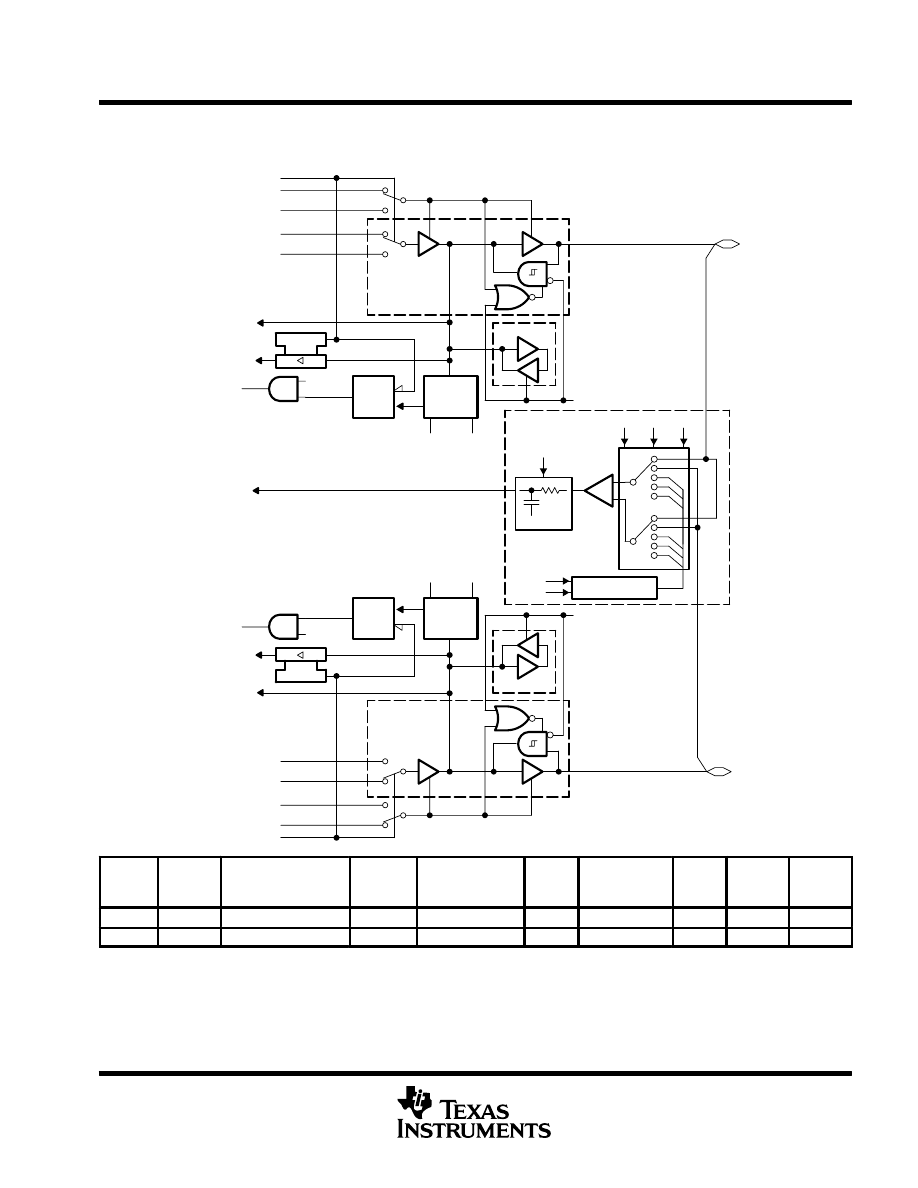
MSP430x12x
MIXED SIGNAL MICROCONTROLLER
SLAS312A – JULY 2001 – REVISED MARCH 2003
27
POST OFFICE BOX 655303
•
DALLAS, TEXAS 75265
APPLICATION INFORMATION
Port P2, P2.3 to P2.4, input/output with Schmitt-trigger
EN
D
P2.3/CA0/TA1
0
1
0
1
Interrupt
Edge
Select
EN
Set
Q
P2IE.3
P2IFG.3
P2IRQ.3
Interrupt
Flag
P2IES.3
P2SEL.3
Module X IN
P2IN.3
P2OUT.3
Module X
OUT
Direction Control
From Module
P2DIR.3
P2SEL.3
Pad Logic
0: Input
1: Output
Bus Keeper
CAPD.3
EN
D
P2.4/CA1/TA2
1
0
1
0
Interrupt
Edge
Select
EN
Set
Q
P2IE.4
P2IFG.4
P2IRQ.4
Interrupt
Flag
P2IES.4
P2SEL.4
Module X IN
P2IN.4
P2OUT.4
Module X OUT
Direction Control
From Module
P2DIR.4
P2SEL.4
Pad Logic
0: Input
1: Output
Bus Keeper
CAPD.4
_
+
Comparator_A
Reference Block
CAREF
CAREF
CAEX
P2CA
CAF
CCI1B
0 V
PnSel.x
PnDIR.x
DIRECTION
CONTROL
FROM MODULE
PnOUT.x
MODULE X OUT
PnIN.x
MODULE X IN
PnIE.x
PnIFG.x
PnIES.x
P2Sel.3
P2DIR.3
P2DIR.3
P2OUT.3
Out1 signal†
P2IN.3
unused
P2IE.3
P2IFG.3
P1IES.3
P2Sel.4
P2DIR.4
P2DIR.4
P2OUT.4
Out2 signal†
P2IN.4
unused
P2IE.4
P2IFG.4
P1IES.4
† Signal from Timer_A
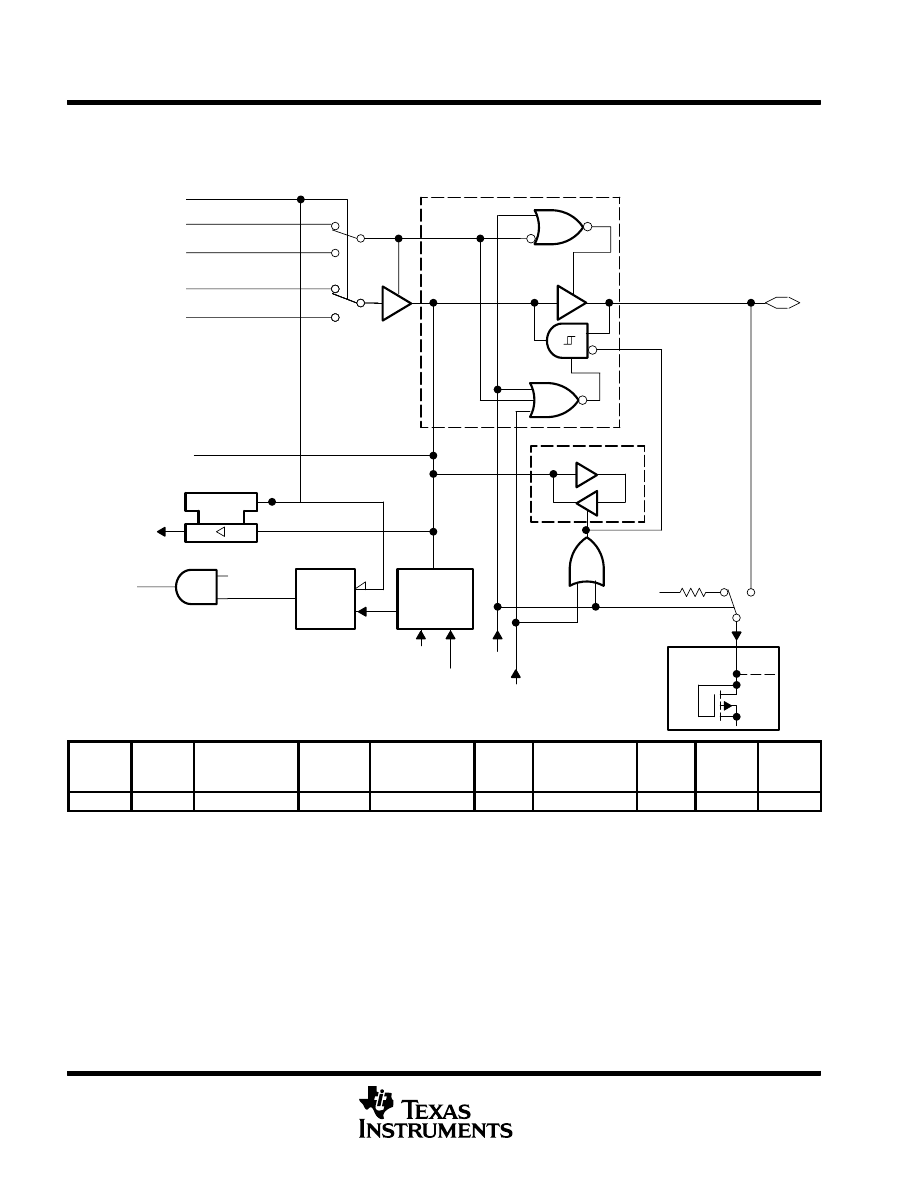
MSP430x12x
MIXED SIGNAL MICROCONTROLLER
SLAS312A – JULY 2001 – REVISED MARCH 2003
28
POST OFFICE BOX 655303
•
DALLAS, TEXAS 75265
APPLICATION INFORMATION
Port P2, P2.5, input/output with Schmitt-trigger and R
OSC
function for the Basic Clock module
EN
D
P2.5/ROSC
0
1
0
1
Interrupt
Edge
Select
EN
Set
Q
P2IE.5
P2IFG.5
P2IRQ.5
Interrupt
Flag
P2IES.5
P2SEL.5
Module X IN
P2IN.5
P2OUT.5
Module X OUT
Direction Control
From Module
P2DIR.5
P2SEL.5
Pad Logic
NOTE: DCOR: Control bit from Basic Clock Module if it is set, P2.5 Is disconnected from P2.5 pad
Bus Keeper
0
1
0
1
VCC
Internal to
Basic Clock
Module
DCOR
DC
Generator
0: Input
1: Output
CAPD.5
PnSel.x
PnDIR.x
DIRECTION
CONTROL
FROM MODULE
PnOUT.x
MODULE X OUT
PnIN.x
MODULE X IN
PnIE.x
PnIFG.x
PnIES.x
P2Sel.5
P2DIR.5
P2DIR.5
P2OUT.5
VSS
P2IN.5
unused
P2IE.5
P2IFG.5
P2IES.5
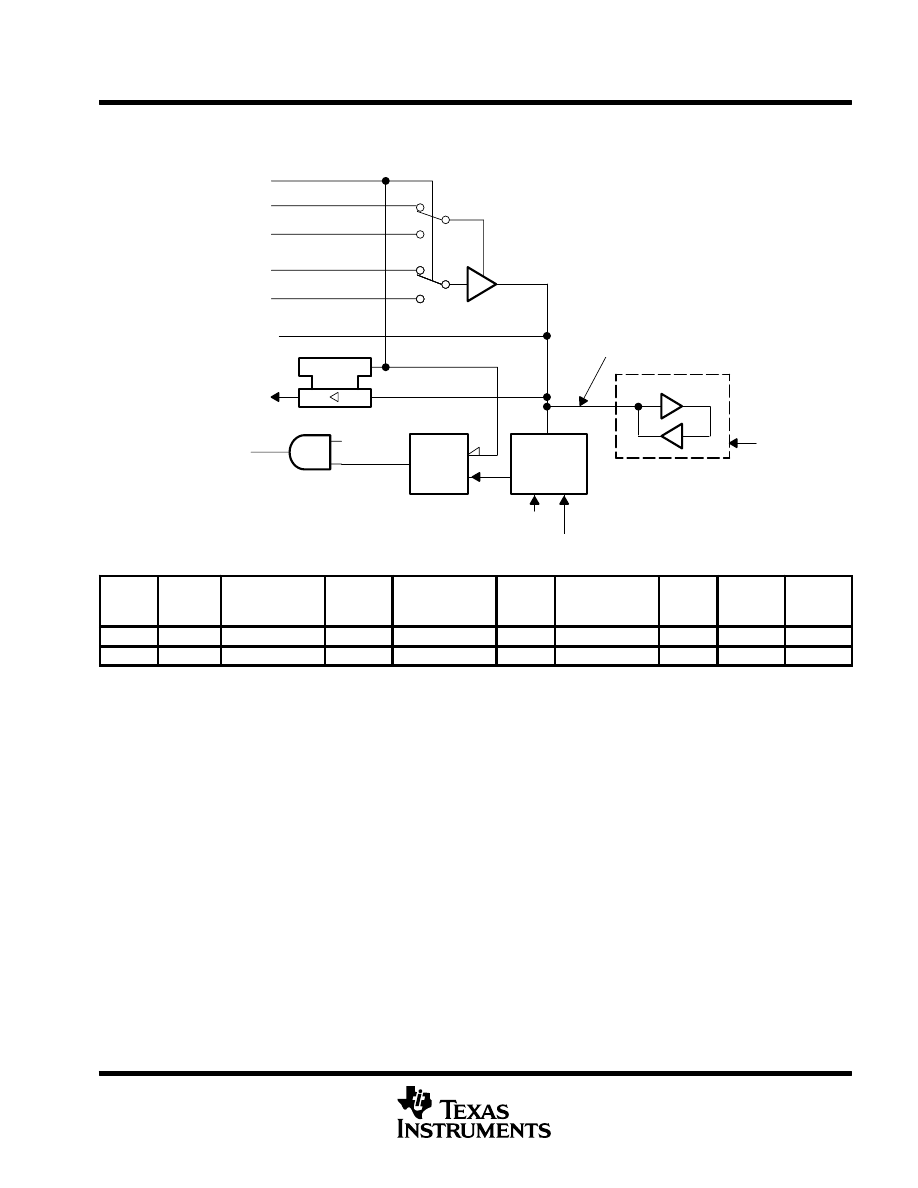
MSP430x12x
MIXED SIGNAL MICROCONTROLLER
SLAS312A – JULY 2001 – REVISED MARCH 2003
29
POST OFFICE BOX 655303
•
DALLAS, TEXAS 75265
APPLICATION INFORMATION
Port P2, unbonded bits P2.6 and P2.7
EN
D
0
1
0
1
Interrupt
Edge
Select
EN
Set
Q
P2IE.x
P2IFG.x
P2IRQ.x
Interrupt
Flag
P2IES.x
P2SEL.x
Module X IN
P2IN.x
P2OUT.x
Module X OUT
Direction Control
From Module
P2DIR.x
P2SEL.x
Bus Keeper
0
1
0: Input
1: Output
Node Is Reset With PUC
PUC
NOTE: x = Bit/identifier, 6 to 7 for port P2 without external pins
P2Sel.x
P2DIR.x
DIRECTION-
CONTROL
FROM MODULE
P2OUT.x
MODULE X OUT
P2IN.x
MODULE X IN
P2IE.x
P2IFG.x
P2IES.x
P2Sel.6
P2DIR.6
P2DIR.6
P2OUT.6
VSS
P2IN.6
unused
P2IE.6
P2IFG.6
P2IES.6
P2Sel.7
P2DIR.7
P2DIR.7
P2OUT.7
VSS
P2IN.7
unused
P2IE.7
P2IFG.7
P2IES.7
NOTE: Unbonded bits 6 and 7 of port P2 can be used as interrupt flags. Only software can affect the interrupt flags. They work as software
interrupts.
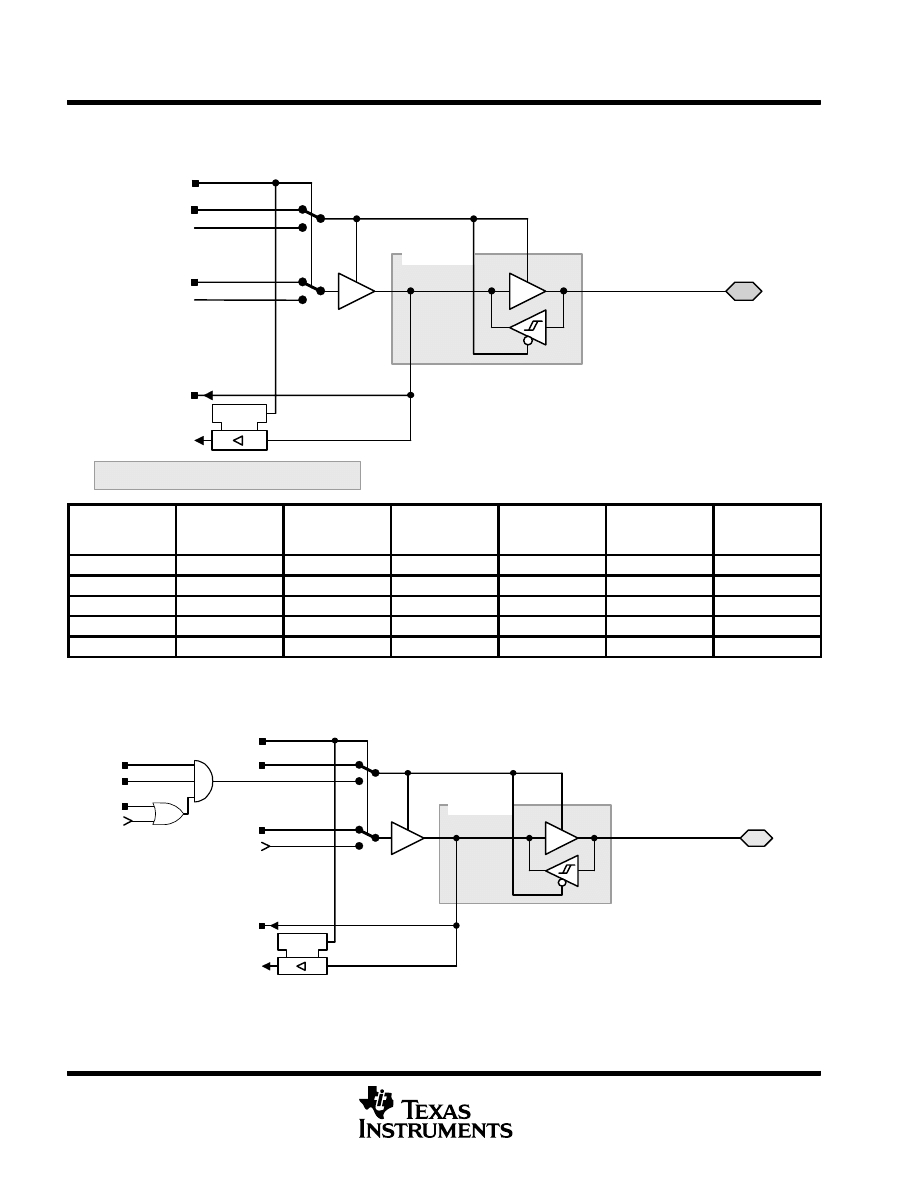
MSP430x12x
MIXED SIGNAL MICROCONTROLLER
SLAS312A – JULY 2001 – REVISED MARCH 2003
30
POST OFFICE BOX 655303
•
DALLAS, TEXAS 75265
APPLICATION INFORMATION
port P3, P3.0 and P3.4 to P3.7, input/output with Schmitt-trigger
P3.0/STE0
P3IN.x
Module X IN
Pad Logic
EN
D
P3OUT.x
P3DIR.x
P3SEL.x
Module X OUT
Direction Control
From Module
0
1
0
1
P3.4/UTXD0
P3.5/URXD0
0: Input
1: Output
x: Bit Identifier, 0 and 4 to 7 for Port P3
P3.6
P3.7
PnSel.x
PnDIR.x
DIRECTION
CONTROL
FROM MODULE
PnOUT.x
MODULE X OUT
PnIN.x
MODULE X IN
P3Sel.0
P3DIR.0
VSS
P3OUT.0
VSS
P3IN.0
STE0
P3Sel.4
P3DIR.4
VCC
P3OUT.4
UTXD0†
P3IN.4
Unused
P3Sel.5
P3DIR.5
VSS
P3OUT.5
VSS
P3IN.5
URXD0‡
P3Sel.6
P3DIR.6
VSS
P3OUT.6
VSS
P3IN.6
Unused
P3Sel.7
P3DIR.7
VSS
P3OUT.7
VSS
P3IN.7
Unused
† Output from USART0 module
‡ Input to USART0 module
port P3, P3.1, input/output with Schmitt-trigger
P3.1/SIMO0
P3IN.1
Pad Logic
EN
D
P3OUT1
P3DIR.1
P3SEL.1
(SI)MO0
0
1
0
1
DCM_SIMO
SYNC
MM
STE
STC
From USART0
SI(MO)0
To USART0
0: Input
1: Output
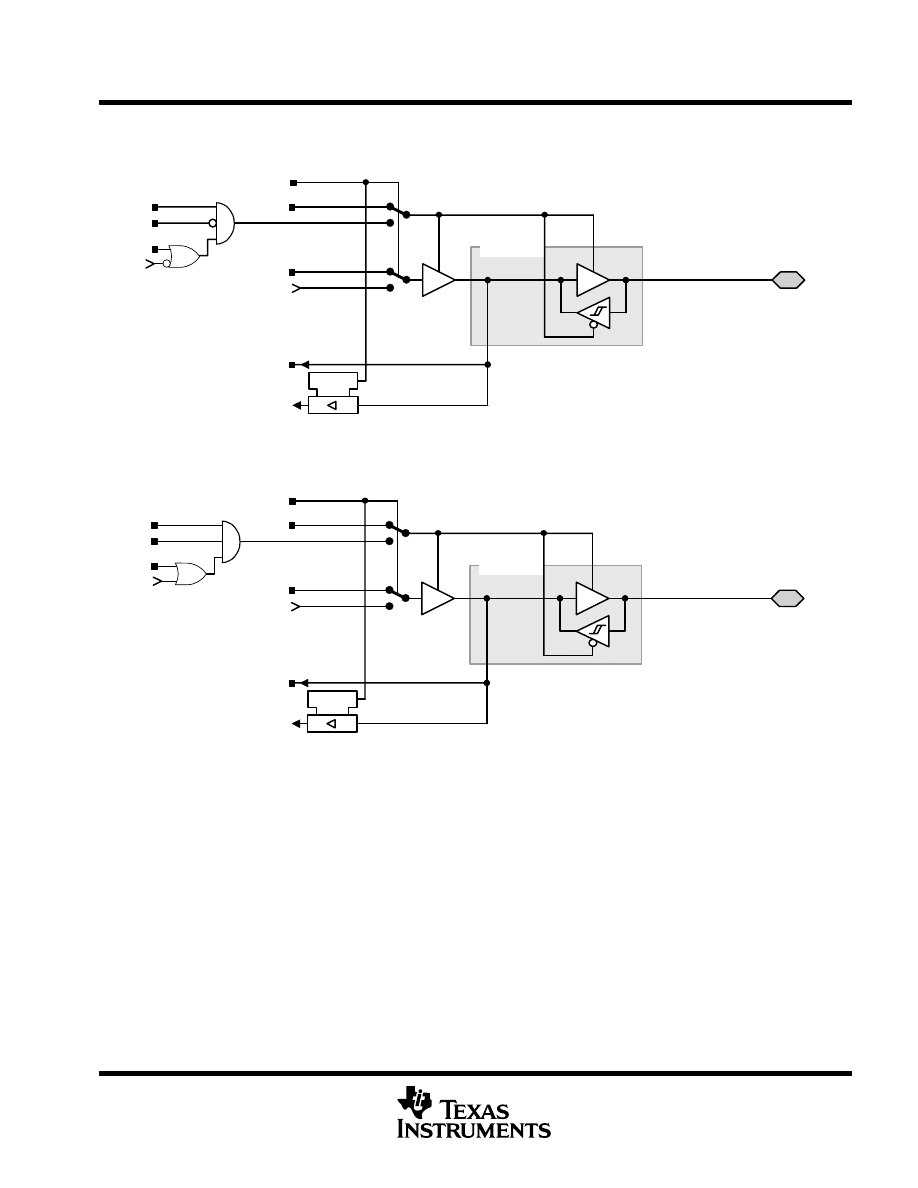
MSP430x12x
MIXED SIGNAL MICROCONTROLLER
SLAS312A – JULY 2001 – REVISED MARCH 2003
31
POST OFFICE BOX 655303
•
DALLAS, TEXAS 75265
APPLICATION INFORMATION
port P3, P3.2, input/output with Schmitt-trigger
P3.2/SOMI0
P3IN.2
Pad Logic
EN
D
P3OUT.2
P3DIR.2
P3SEL.2
0
1
0
1
DCM_SOMI
SYNC
MM
STE
STC
SO(MI)0
From USART0
(SO)MI0
To USART0
0: Input
1: Output
port P3, P3.3, input/output with Schmitt-trigger
P3.3/UCLK0
P3IN.3
Pad Logic
EN
D
P3OUT.3
P3DIR.3
P3SEL.3
UCLK.0
0
1
0
1
DCM_UCLK
SYNC
MM
STE
STC
From USART0
UCLK0
To USART0
0: Input
1: Output
NOTE: UART mode:
The UART clock can only be an input. If UART mode and UART function are selected, the P3.3/UCLK0 is always
an input.
SPI, slave mode:
The clock applied to UCLK0 is used to shift data in and out.
SPI, master mode:
The clock to shift data in and out is supplied to connected devices on pin P3.3/UCLK0 (in slave mode).
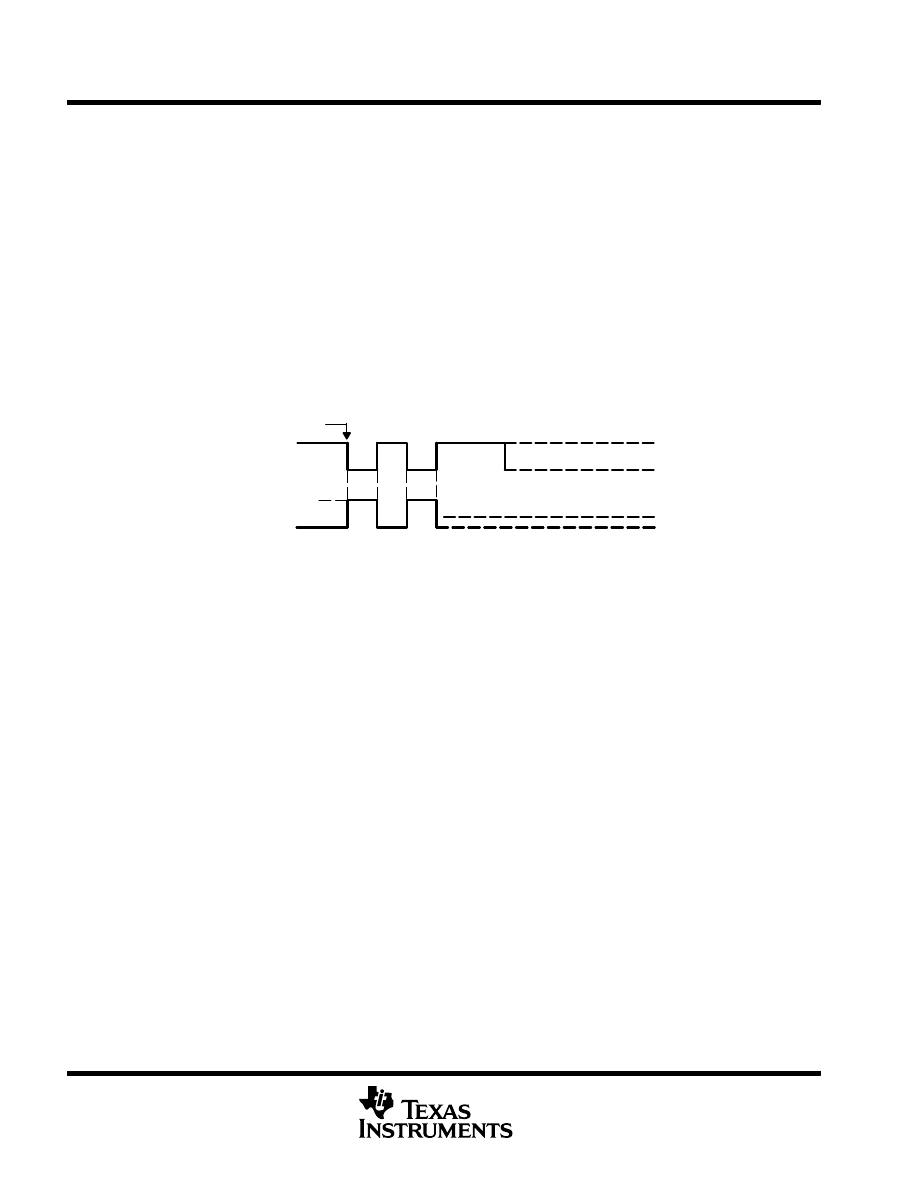
MSP430x12x
MIXED SIGNAL MICROCONTROLLER
SLAS312A – JULY 2001 – REVISED MARCH 2003
32
POST OFFICE BOX 655303
•
DALLAS, TEXAS 75265
JTAG fuse check mode
MSP430 devices that have the fuse on the TEST terminal have a fuse check mode that tests the continuity of
the fuse the first time the JTAG port is accessed after a power-on reset (POR). When activated, a fuse check
current, a fuse check current, I
TF
, of 1 mA at 3 V, 2.5 mA at 5 V can flow from from the TEST pin to ground if
the fuse is not burned. Care must be taken to avoid accidentally activating the fuse check mode and increasing
overall system power consumption.
When the TEST pin is taken back low after a test or programming session, the fuse check mode and sense
currents are terminated.
Activation of the fuse check mode occurs with the first negative edge on the TMS pin after power up or if the
TMS is being held low during power up. The second positive edge on the TMS pin deactivates the fuse check
mode. After deactivation, the fuse check mode remains inactive until another POR occurs. After each POR the
fuse check mode has the potential to be activated.
The fuse check current will only flow when the fuse check mode is active and the TMS pin is in a low state (see
Figure 13). Therefore, the additional current flow can be prevented by holding the TMS pin high (default
condition).
Time TMS Goes Low After POR
TMS
ITF
ITEST
Figure 13. Fuse Check Mode Current, MSP430F12x
NOTE:
The CODE and RAM data protection is ensured if the JTAG fuse is blown and the 256-bit bootloader
access key is used. Also see the bootstrap loader section for more information.
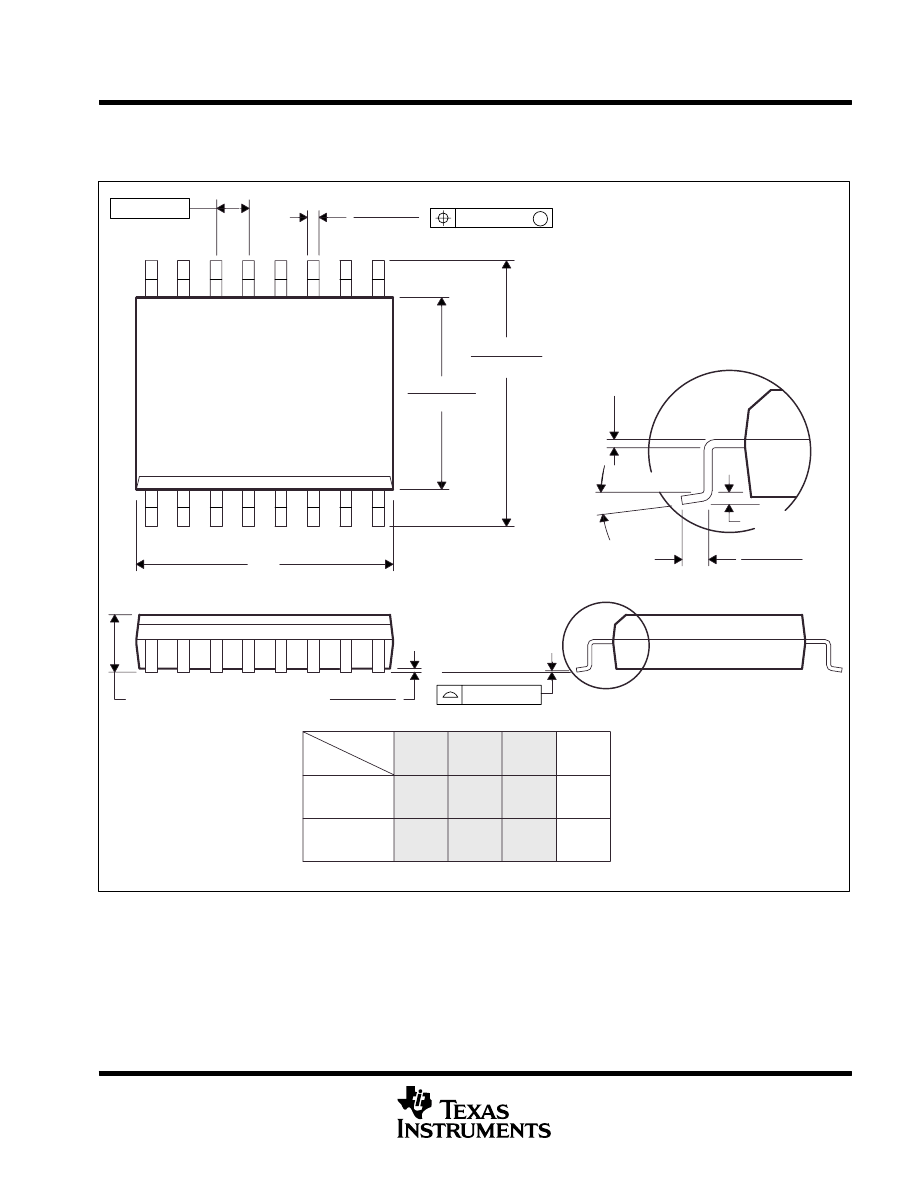
MSP430x12x
MIXED SIGNAL MICROCONTROLLER
SLAS312A – JULY 2001 – REVISED MARCH 2003
33
POST OFFICE BOX 655303
•
DALLAS, TEXAS 75265
MECHANICAL DATA
DW (R-PDSO-G**)
PLASTIC SMALL-OUTLINE PACKAGE
16 PINS SHOWN
4040000 / D 01/00
Seating Plane
0.400 (10,15)
0.419 (10,65)
0.104 (2,65) MAX
1
0.012 (0,30)
0.004 (0,10)
A
8
16
0.020 (0,51)
0.014 (0,35)
0.291 (7,39)
0.299 (7,59)
9
0.010 (0,25)
0.050 (1,27)
0.016 (0,40)
(15,24)
(15,49)
PINS **
0.010 (0,25) NOM
A MAX
DIM
A MIN
Gage Plane
20
0.500
(12,70)
(12,95)
0.510
(10,16)
(10,41)
0.400
0.410
16
0.600
24
0.610
(17,78)
28
0.700
(18,03)
0.710
0.004 (0,10)
M
0.010 (0,25)
0.050 (1,27)
0
°
– 8
°
NOTES: A. All linear dimensions are in inches (millimeters).
B. This drawing is subject to change without notice.
C. Body dimensions do not include mold flash or protrusion not to exceed 0.006 (0,15).
D. Falls within JEDEC MS-013
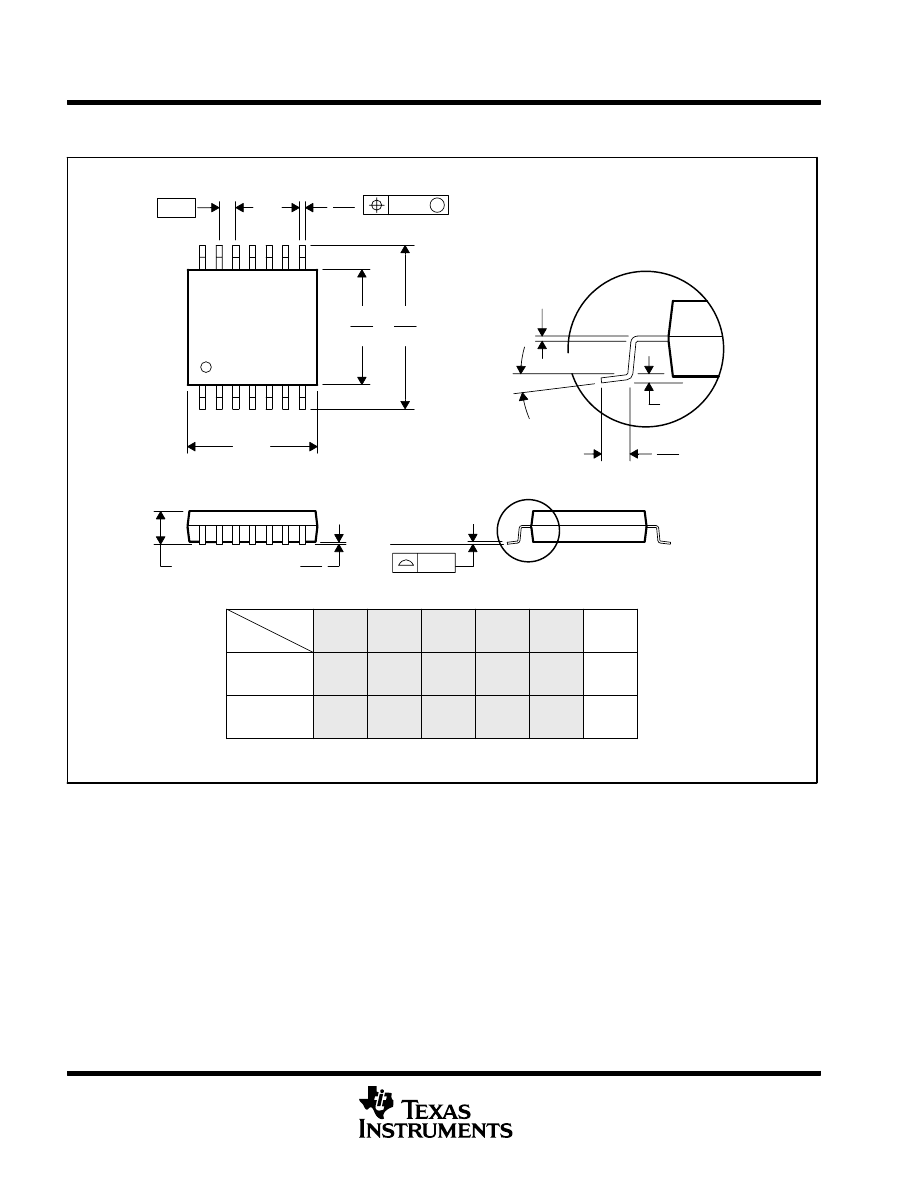
MSP430x12x
MIXED SIGNAL MICROCONTROLLER
SLAS312A – JULY 2001 – REVISED MARCH 2003
34
POST OFFICE BOX 655303
•
DALLAS, TEXAS 75265
PW (R-PDSO-G**)
PLASTIC SMALL-OUTLINE PACKAGE
14 PINS SHOWN
0,65
M
0,10
0,10
0,25
0,50
0,75
0,15 NOM
Gage Plane
28
9,80
9,60
24
7,90
7,70
20
16
6,60
6,40
4040064/F 01/97
0,30
6,60
6,20
8
0,19
4,30
4,50
7
0,15
14
A
1
1,20 MAX
14
5,10
4,90
8
3,10
2,90
A MAX
A MIN
DIM
PINS **
0,05
4,90
5,10
Seating Plane
0
°
– 8
°
NOTES: A. All linear dimensions are in millimeters.
B. This drawing is subject to change without notice.
C. Body dimensions do not include mold flash or protrusion not to exceed 0,15.
D. Falls within JEDEC MO-153

IMPORTANT NOTICE
Texas Instruments Incorporated and its subsidiaries (TI) reserve the right to make corrections, modifications,
enhancements, improvements, and other changes to its products and services at any time and to discontinue
any product or service without notice. Customers should obtain the latest relevant information before placing
orders and should verify that such information is current and complete. All products are sold subject to TI’s terms
and conditions of sale supplied at the time of order acknowledgment.
TI warrants performance of its hardware products to the specifications applicable at the time of sale in
accordance with TI’s standard warranty. Testing and other quality control techniques are used to the extent TI
deems necessary to support this warranty. Except where mandated by government requirements, testing of all
parameters of each product is not necessarily performed.
TI assumes no liability for applications assistance or customer product design. Customers are responsible for
their products and applications using TI components. To minimize the risks associated with customer products
and applications, customers should provide adequate design and operating safeguards.
TI does not warrant or represent that any license, either express or implied, is granted under any TI patent right,
copyright, mask work right, or other TI intellectual property right relating to any combination, machine, or process
in which TI products or services are used. Information published by TI regarding third–party products or services
does not constitute a license from TI to use such products or services or a warranty or endorsement thereof.
Use of such information may require a license from a third party under the patents or other intellectual property
of the third party, or a license from TI under the patents or other intellectual property of TI.
Reproduction of information in TI data books or data sheets is permissible only if reproduction is without
alteration and is accompanied by all associated warranties, conditions, limitations, and notices. Reproduction
of this information with alteration is an unfair and deceptive business practice. TI is not responsible or liable for
such altered documentation.
Resale of TI products or services with statements different from or beyond the parameters stated by TI for that
product or service voids all express and any implied warranties for the associated TI product or service and
is an unfair and deceptive business practice. TI is not responsible or liable for any such statements.
Mailing Address:
Texas Instruments
Post Office Box 655303
Dallas, Texas 75265
Copyright
2003, Texas Instruments Incorporated
Document Outline
- features
- description
- functional block diagram
- Terminal Functions
- short-form description
- special function registers
- memory organization
- bootstrap loader (BSL)
- flash memory
- peripherals
- oscillator and system clock
- digital I/O
- watchdog timer
- USART0
- timer_A3
- comparator_A
- peripheral file map
- absolute maximum ratings
- recommended operating conditions
- electrical characteristics over recommended ranges of supply voltage and\
operating free-air temperature (unless otherwise noted)
- supply current (into V CC ) excluding external current
- current consumption of active mode versus system frequency
- current consumption of active mode versus supply voltage
- Schmitt-trigger inputs Port P1 to Port P3; P1.0 to P1.7, P2.0 to P2.5, P\ 3.0 to P3.7
- outputs Port 1 to P3; P1.0 to P1.7, P2.0 to P2.5, P3.0 to P3.7
- outputs – Ports P1, P2, and P3
- leakage current
- inputs Px.x, TAx
- USART (see Note 1)
- outputs P1.x, P2.x, P3.x, TAx
- Comparator_A (see Note 1)
- PUC/POR
- RAM
- crystal oscillator,LFXT1
- DCO
- principle characteristics of the DCO
- wake-up from lower power modes (LPMx)
- JTAG, program memory and fuse
- APPLICATION INFORMATION
- input/output schematic
- Port P1, P1.0 to P1.3, input/output with Schmitt-trigger
- Port P1, P1.4 to P1.7, input/output with Schmitt-trigger and in-system a\ ccess features
- Port P2, P2.0 to P2.2, input/output with Schmitt-trigger
- Port P2, P2.3 to P2.4, input/output with Schmitt-trigger
- Port P2, P2.5, input/output with Schmitt-trigger and R OSC function for \ the Basic
- Port P2, unbonded bits P2.6 and P2.7
- port P3, P3.0 and P3.4 to P3.7, input/output with Schmitt-trigger
- port P3, P3.1, input/output with Schmitt-trigger
- port P3, P3.2, input/output with Schmitt-trigger
- port P3, P3.3, input/output with Schmitt-trigger
- JTAG fuse check mode
- input/output schematic
- MECHANICAL DATA
- IMPORTANT NOTICE
Wyszukiwarka
Podobne podstrony:
3 LCD LCD MSP430 id 755238 Nieznany (2)
msp430f1122
msp430g2553
MSP430 2005www
MSP430 wprzykładach cz2
MSP430X
MSP430 wprzykładach cz3
msp430f149 (2)
msp430fg4618
msp430 opis p ytki
MSP430 wprzykładach cz1
msp430f133
MSP430 wprzykładach cz8
msp430f110
msp430f1101a
msp430f149
MSP430 wprzykładach cz6
więcej podobnych podstron